Search Result
Results for "
AML cells
" in MedChemExpress (MCE) Product Catalog:
| Cat. No. |
Product Name |
Target |
Research Areas |
Chemical Structure |
-
- HY-P99390
-
|
MCLA 117
|
CD3
|
Cancer
|
|
Tepoditamab (MCLA-117) is a bispecific monoclonal antibody that binds to CLEC12A of myeloid cells and CD3 of cytotoxic T cells. Among others, CLEC12A is a myeloid differentiation antigen. Tepoditamab (MCLA-117) kills AML leukaemia mother cells and AML leukaemia stem cells, induces T cell-mediated proliferative lysis of AML cells and can be used in acute myeloid leukaemia (AML) research .
|
-

-
- HY-120084
-
|
|
Casein Kinase
|
Cancer
|
|
BTX161, a Thalidomide analog, is a potent CKIα degrader. BTX161 mediates degradation of CKIα better than Lenalidomide in human AML cells and activates DNA damage response (DDR) and p53, while stabilizing the p53 antagonist MDM2 .
|
-

-
- HY-153604
-
|
|
Histone Acetyltransferase
|
Cancer
|
|
MC4171 (compound 34) is a selective KAT8 inhibitor (IC50=8.1 µM). MC4171 has been shown to exhibit moderate micromolar antiproliferative activity in different cancer cell lines, including NSCLC and AML, with potential for studying cancer .
|
-
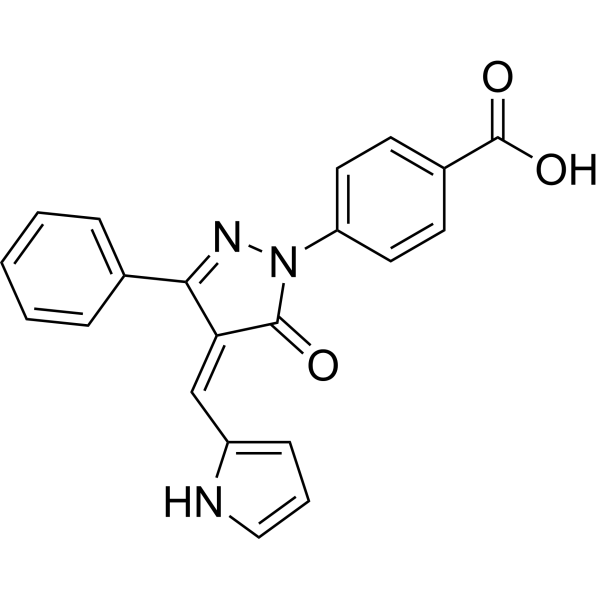
-
- HY-157481
-
|
|
HDAC
|
Cancer
|
|
HDAC1-IN-6 (compound 1) is an inhibitor of HDAC1 and 11, with an IC50 of 1.9 μM and 1.6 μM, respectively. HDAC1-IN-6 induces differentiation in AML cells .
|
-
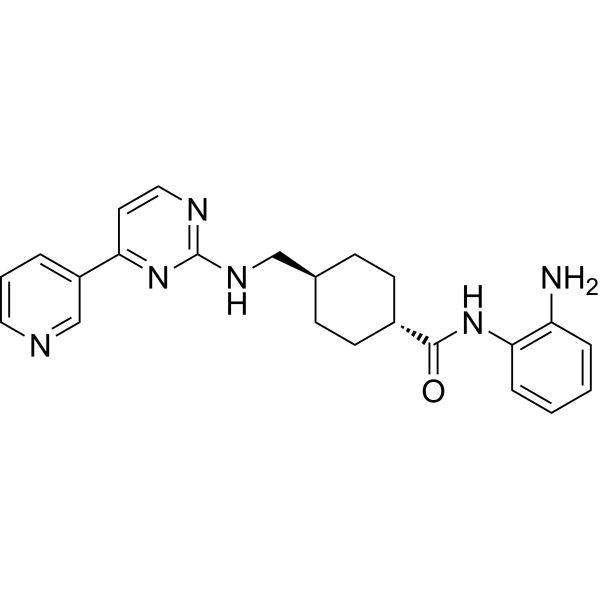
-
- HY-129388A
-
|
CC-90011; LSD1-IN-7
|
Histone Demethylase
|
Cancer
|
|
Pulrodemstat (CC-90011) is a potent, selective, reversible and orally active inhibitor of lysine specific demethylase-1 (LSD1) with an IC50 of 0.25 nM. Pulrodemstat is less enzymatic inhibition against LSD2, MOA-A, and MAO-B. Pulrodemstat induces acute myeloid leukemia (AML) and small cell lung cancer (SCLC) cells differentiation and has potent anticancer activity .
|
-
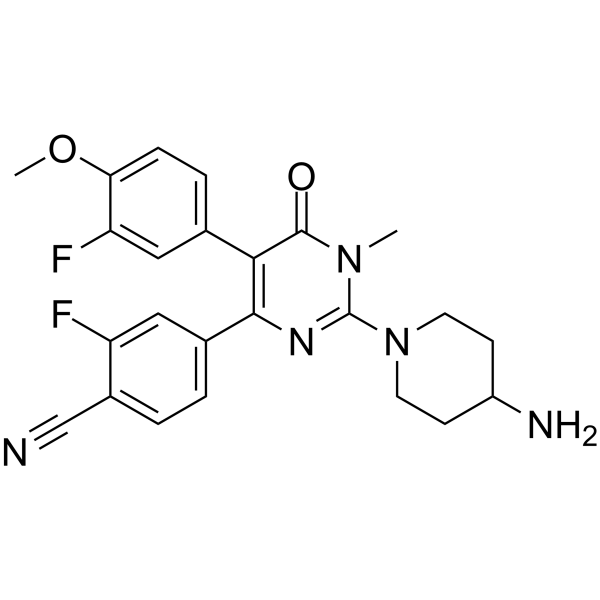
-
- HY-142696
-
|
|
CDK
Pim
Apoptosis
|
Cancer
|
CDK6/PIM1-IN-1 is a potent and balanced dual CDK6/PIM1 inhibitor with IC50 values of 39 and 88 nM, respectively. CDK6/PIM1-IN-1 inhibits CDK4 (IC50=3.6 nM). CDK6/PIM1-IN-1 significantly inhibits acute myeloid leukemia (AML) cell proliferation, arrest cell cycle at the G1 phase, and promote cell apoptosis. CDK6/PIM1-IN-1 exhibits potent anti-AML activity .
|
-

-
- HY-16981
-
|
|
CXCR
|
Inflammation/Immunology
|
|
SB-332235 is a potent, orally active nonpeptide CXCR2 antagonist, with an IC50 of 7.7 nM. SB-332235 displays 285-fold selectivity for CXCR2 over CXCR1. SB-332235 inhibits acute and chronic models of arthritis in the rabbit. SB-332235 inhibits viability of AML cells .
|
-
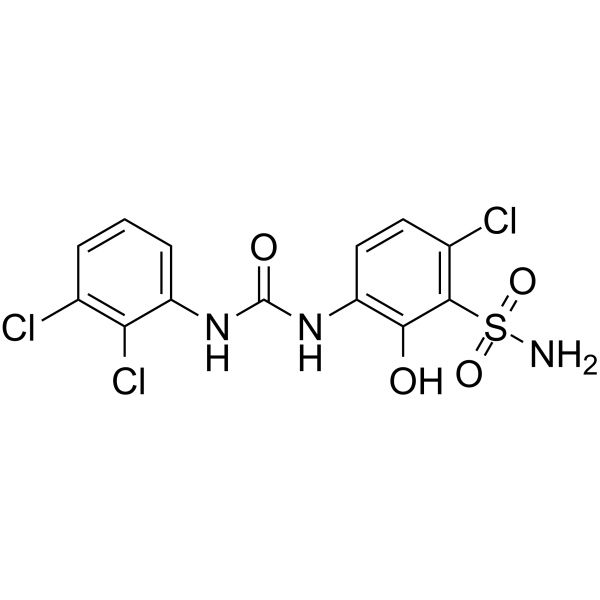
-
- HY-129388B
-
|
CC-90011 benzenesulfonate; LSD1-IN-7 benzenesulfonate
|
Histone Demethylase
|
Cancer
|
|
CC-90011 benzenesulfonate is a potent, selective, reversible and orally active inhibitor of lysine specific demethylase-1 (LSD1) with an IC50 of 0.25 nM. CC-90011 benzenesulfonate is less enzymatic inhibition against LSD2, MOA-A, and MAO-B. CC-90011 benzenesulfonate induces acute myeloid leukemia (AML) and small cell lung cancer (SCLC) cells differentiation and has potent anticancer activity .
|
-
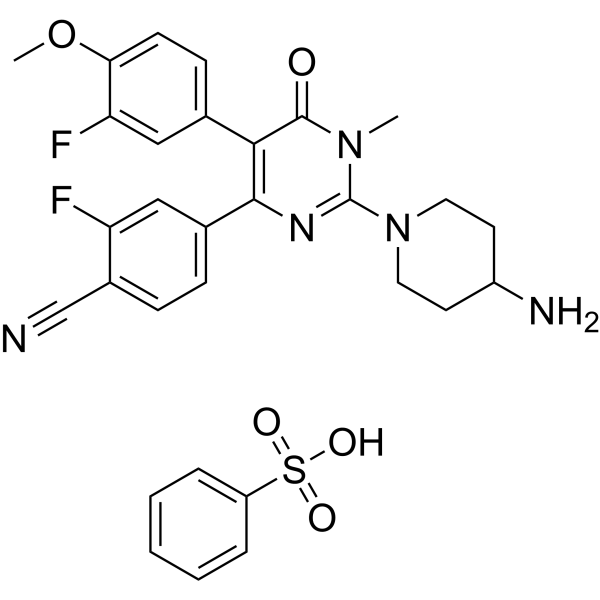
-
- HY-129388
-
|
CC-90011 Methylbenzenesulfonate; LSD1-IN-7 Methylbenzenesulfonate
|
Histone Demethylase
|
Cancer
|
|
CC-90011 Methylbenzenesulfonate is a potent, selective, reversible and orally active inhibitor of lysine specific demethylase-1 (LSD1) with an IC50 of 0.25 nM. CC-90011 Methylbenzenesulfonate is less enzymatic inhibition against LSD2, MOA-A, and MAO-B. CC-90011 Methylbenzenesulfonate induces acute myeloid leukemia (AML) and small cell lung cancer (SCLC) cells differentiation and has potent anticancer activity .
|
-
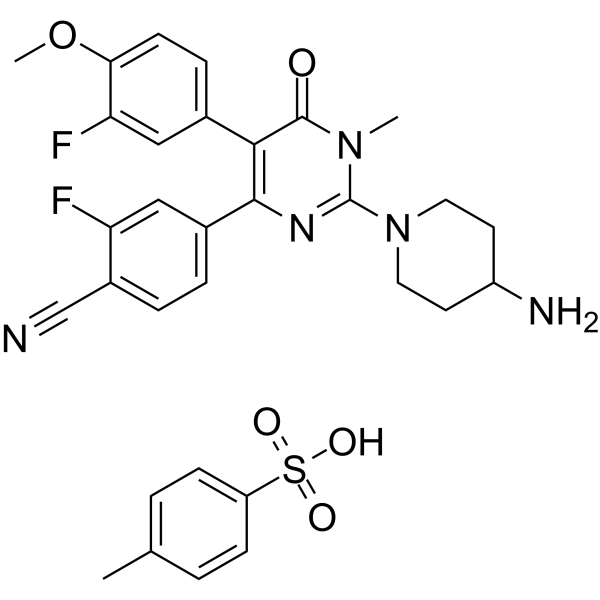
-
- HY-129099
-
|
|
PKC
Estrogen Receptor/ERR
Drug Metabolite
Endogenous Metabolite
|
Cancer
|
|
N-Desmethyltamoxifen is the major metabolite of tamoxifen in humans. N-Desmethyltamoxifen, a poor antiestrogen, is a ten-fold more potent protein kinase C (PKC) inhibitor than Tamoxifen. N-Desmethyltamoxifen is also a potent regulator of ceramide metabolism in human AML cells, limiting ceramide glycosylation, hydrolysis, and sphingosine phosphorylation .
|
-

-
- HY-129099A
-
|
|
PKC
Estrogen Receptor/ERR
Drug Metabolite
Endogenous Metabolite
|
Cancer
|
|
N-Desmethyltamoxifen hydrochloride is the major metabolite of tamoxifen in humans. N-Desmethyltamoxifen, a poor antiestrogen, is a ten-fold more potent protein kinase C (PKC) inhibitor than Tamoxifen. N-Desmethyltamoxifen hydrochloride is also a potent regulator of ceramide metabolism in human AML cells, limiting ceramide glycosylation, hydrolysis, and sphingosine phosphorylation .
|
-
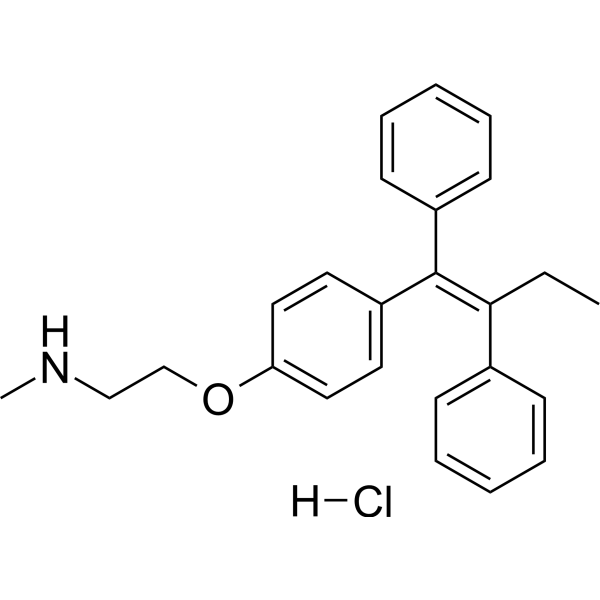
-
- HY-143238
-
|
|
Histone Demethylase
|
Cancer
|
|
FY-56 is a highly potent and selective LSD1/KDM1A inhibitor (IC50=42 nM) and exhibits high selectivity over MAO-A/B. FY-56 induces differentiation of MOLM-13 and MV4-11 cell and has the potential for AML research .
|
-
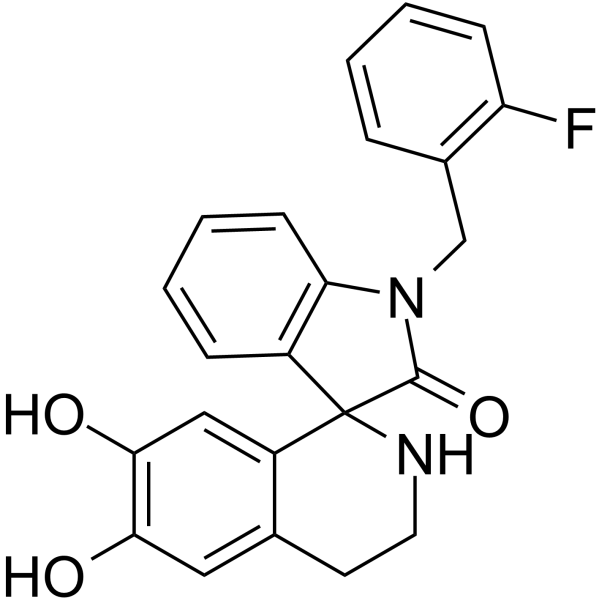
-
- HY-148422
-
|
|
Eukaryotic Initiation Factor (eIF)
Apoptosis
|
Cancer
|
|
Rohinitib is a potent and specific eIF4A inhibitor. Rohinitib induces cell apoptosis of acute myeloid leukemia (AML) cell lines and reduces the leukemia burden of AML xenograft model. Rohinitib can be used for the research of AML .
|
-

-
- HY-156158
-
|
|
Isocitrate Dehydrogenase (IDH)
|
Cancer
|
|
IDH2 R140Q-IN-2 (compound 36) is an an orally active IDH2 R140Q inhibitor (IC50: 29 nM). IDH2 R140Q-IN-2 reduces D2HG production in TF-1 cell lines expressing mutant IDH2 R140Q (IC50: 10 nM). IDH2 R140Q-IN-2 suppresses D2HG levels in tumor tissue. IDH2 R140Q-IN-2 can be used for research of acute myeloid leukemia (AML) .
|
-
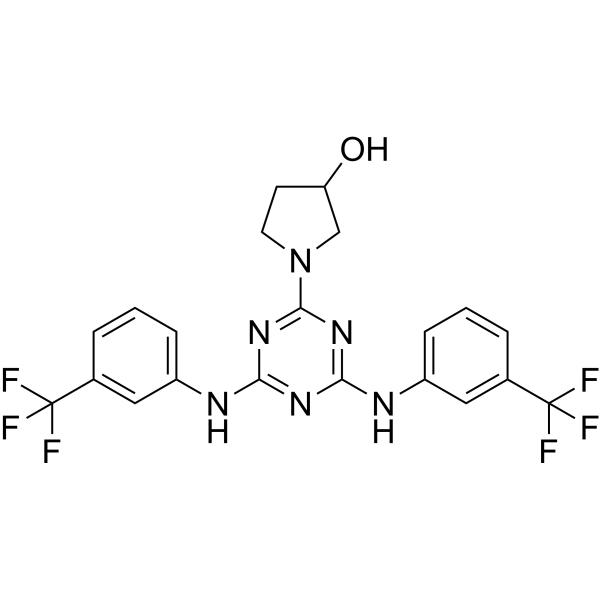
-
- HY-B1336
-
-

-
- HY-110071
-
|
|
c-Kit
|
Cancer
|
|
APcK110 is a potent Kit inhibitor that can be used for the research of acute myeloid leukemia (AML). APcK110 induces AML cell apoptosis .
|
-

-
- HY-150725
-
|
|
IFNAR
TNF Receptor
|
Infection
Inflammation/Immunology
Cancer
|
|
ODN 1585 is a potent inducer of IFN and TNFα production. ODN 1585 is a potent stimulator of NK (natural killer) function. ODN 1585 increases CD8+ T-cell function, including the CD8+ T cell-mediated production of IFN-γ. ODN 1585 induces regression of established melanomas in mice. ODN 1585 can confer complete protection against malaria in mice. ODN 1585 can be used for acute myelogenous leukemia (AML) and malaria research. ODN 1585 can be used as a vaccine adjuvant .
|
-

-
- HY-15815
-
|
|
Epigenetic Reader Domain
Apoptosis
CDK
HIV
|
Cancer
|
|
Bromosporine is a potent BET inhibitor with an IC50 value of 2.1 μM for PCAF. Bromosporine can arrest cell cycle and induce apoptosis in cancer cells. Bromosporine exhibits excellent antitumor activity in xenograft mice model when combined with 5-FU (HY-90006). Bromosporine can increase CDK9 T-loop phosphorylation in HIV-1 latency models, resulting the protection of reactivate HIV-1 replication from latency. Bromosporine can be used to research colorectal cancer, acute myeloid leukemia (AML) and AIDS .
|
-

-
- HY-15972
-
|
|
Fungal
|
Inflammation/Immunology
|
|
UM729 is a new pyrimidoindole, which has an additive effect
with AhR antagonists in preventing differentiation in most AML
specimens; collaborates with Ahr suppressors in preventing AML cell differentiation.
|
-
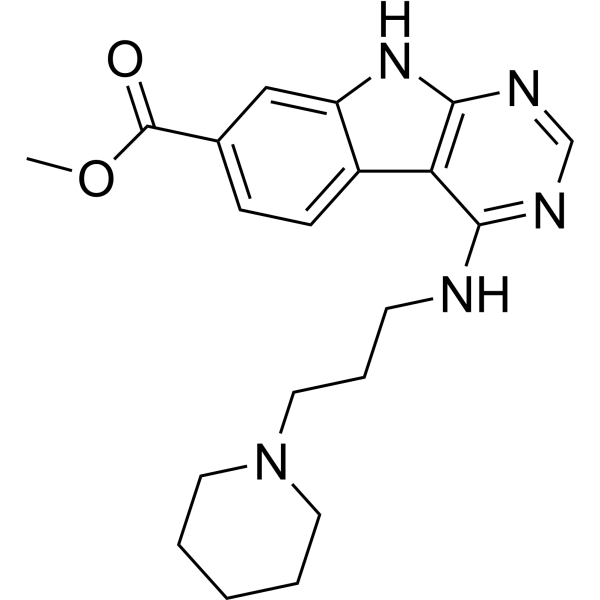
-
- HY-122623
-
|
|
Apoptosis
|
Cancer
|
|
DB818 is a potent inhibitor of Homeobox A9 (HOXA9). HOXA9 is a transcription factor regulating haematopoiesis and leukaemia cell proliferation, involving in acute myeloid leukaemia (AML). DB818 inhibits AML cell lines growth, induces apoptosis .
|
-
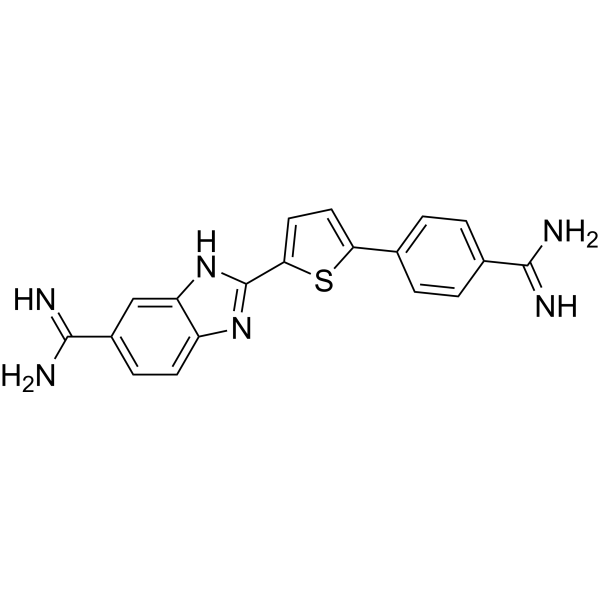
-
- HY-B1336R
-
|
|
Bacterial
Apoptosis
Antibiotic
Parasite
|
Infection
Cancer
|
|
Furazolidone (Standard) is the analytical standard of Furazolidone. This product is intended for research and analytical applications. Furazolidone is a nitrofuran derivative with antiprotozoal and antibacterial activity. It inhibits AML1-ETO transformed cells with an IC50 of 12.7 μM.
|
-

-
- HY-N0071
-
|
Isoguanosine
|
FLT3
HDAC
|
Cancer
|
|
Crotonoside is isolated from Chinese medicinal herb, Croton. Crotonoside inhibits FLT3 and HDAC3/6, exhibits selective inhibition in acute myeloid leukemia (AML) cells. Crotonoside could be a promising new lead compound for the research of AML .
|
-

-
- HY-117690A
-
-
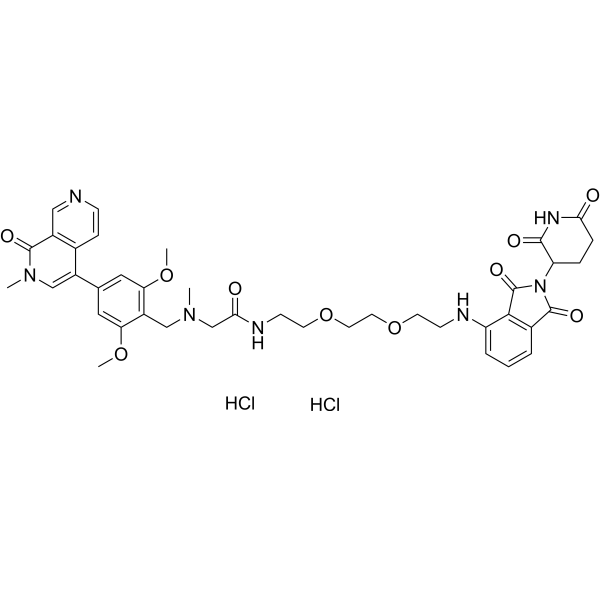
-
- HY-162265
-
|
|
Apoptosis
|
Cancer
|
|
UCM-13369 (Compound 4b) is a NPM1 inhibitor. UCM-13369 downregulates the pathway associated with mutant NPM1 C+, and specifically recognizes the C-end DNA-binding domain of NPM1 C+. UCM-13369 induces apoptosis in AML cell lines and primary cells, that can be used for the research of AML .
|
-
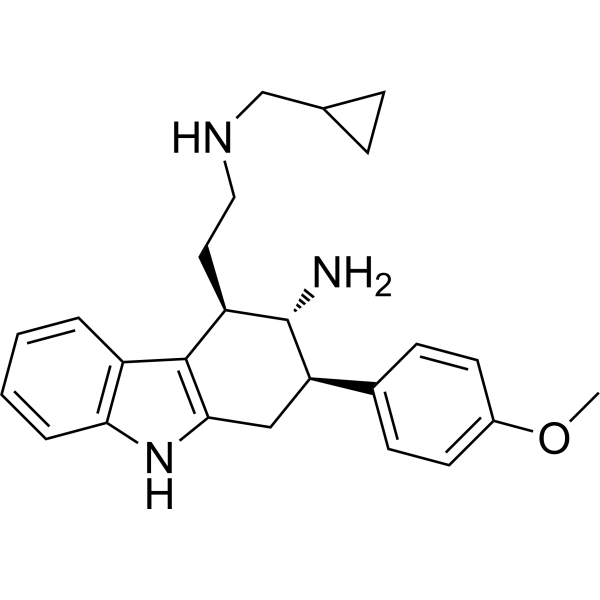
-
- HY-162386
-
|
|
Others
|
Cancer
|
|
UM4118 is a copper ionophore that can initiate a mitochondrial-based noncanonical form of cell death known as cuproptosis. UM4118 exhibits high sensitivity in SF3B1-mutated and adverse risk acute myeloid leukemia (AML), and can be used for AML research .
|
-
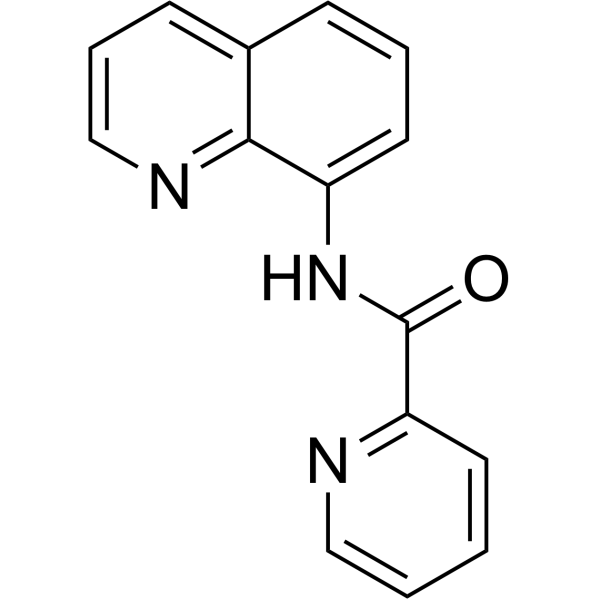
-
- HY-161615
-
|
|
Apoptosis
PROTACs
|
Cancer
|
|
PROTAC ATR degrader-2 (Compound 8i) is a PROTAC degrader for ATR, through of . PROTAC ATR degrader-2 degrades ATR in acute myeloid leukemia (AML) cells MV-4-11 and MOLM-13, with DC50 of 22.9 and 34.5 nM. APROTAC ATR degrader-2 induces apoptosis, inhibits proliferations of AML cells. PROTAC ATR degrader-2 exhibits good pharmacokinetics charachers and antitumor efficacy against AML in mouse model. (Pink: ATR ligand (HY-161616); Blue:E3 ligase ligand Lenalidomide (HY-A0003); Black: linker)
|
-

-
- HY-16172
-
|
Dimethylamino Parthenolide
|
NF-κB
|
Cancer
|
|
DMAPT (Dimethylamino Parthenolide), an analogue of Parthenolide (PTL), is an oral active NF-κB inhibitor, with a LD50 of 1.7 μM for cell population in AML cells. Has potential anti-cancer and anti-metastatic effect .
|
-
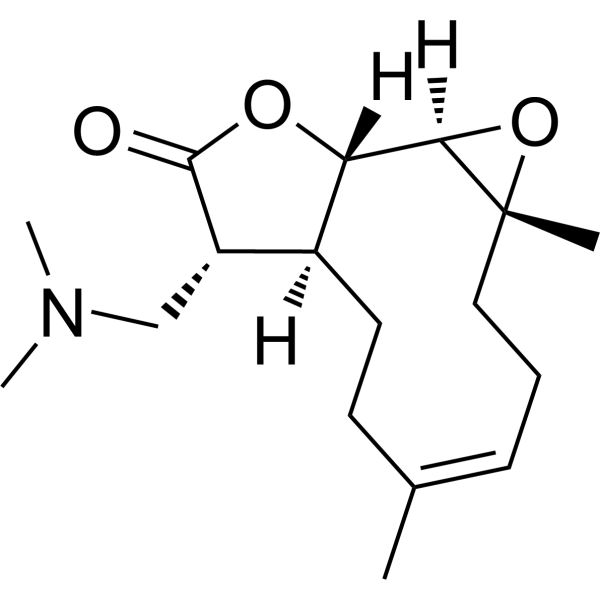
-
- HY-150025
-
|
|
DNA Methyltransferase
Apoptosis
|
Cancer
|
|
(4aS,8aR)-NPD-001 is a potent and allosteric inhibitor of DNMT3A. (4aS,8aR)-NPD-001 inhibits DNMT3A activity by disrupting protein-protein interactions. (4aS,8aR)-NPD-001 induces apoptosis of acute myeloid leukemia (AML) cell lines. (4aS,8aR)-NPD-001 induces differentiation of distinct AML cell lines including cells with mutated DNMT3A R882 .
|
-
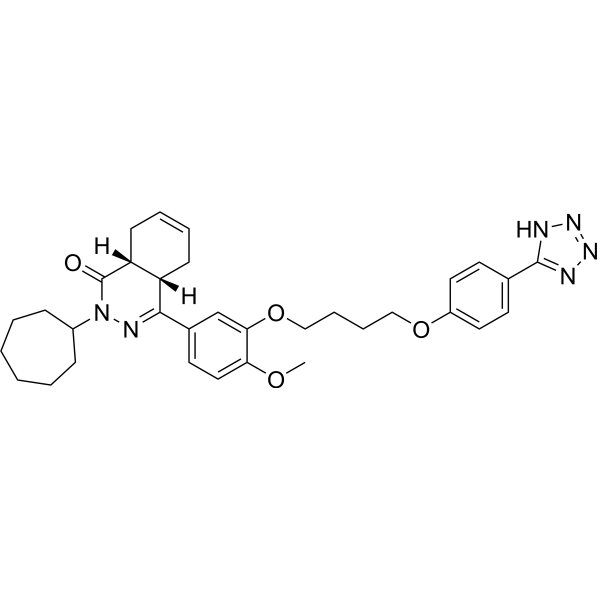
-
- HY-18952A
-
|
|
FLT3
Apoptosis
|
Cancer
|
|
(Z)-SU5614 is a potent FLT3 inhibitor and selectively induces growth arrest, apoptosis, and cell cycle arrest in Ba/F3 and AML cell lines expressing a constitutively activated FLT3 .
|
-
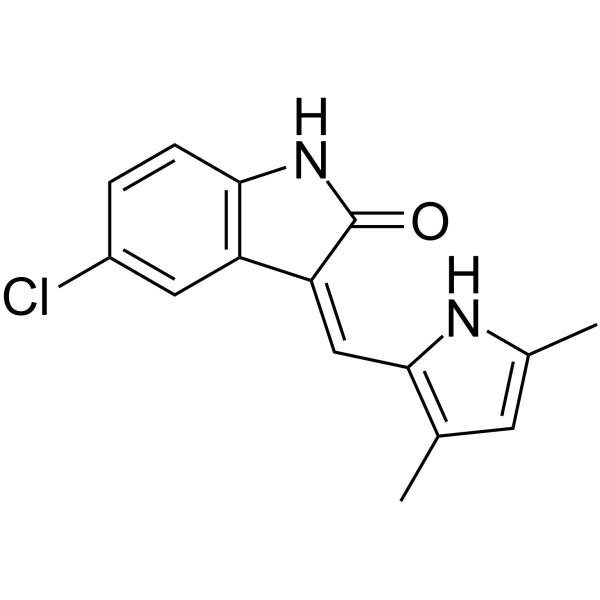
-
- HY-16172A
-
|
(S)-Dimethylamino Parthenolide
|
NF-κB
|
Cancer
|
|
(S)-DMAPT (Dimethylamino Parthenolide), an analogue of Parthenolide (PTL), is an oral active NF-κB inhibitor, with a LD50 of 1.7 μM for cell population in AML cells. Has potential anti-cancer and anti-metastatic effect .
|
-

-
- HY-149522
-
|
|
Bcl-2 Family
Apoptosis
|
Cancer
|
|
BCL6-IN-10 (Compound WK499) is a BCL6 inhibitor. BCL6-IN-10 interrupts the binding of BCL6 to SMRT protein. BCL6-IN-10 induces cell apoptosis, cell cycle arrest and DNA damage. BCL6-IN-10 inhibits AML cell proliferation (IC50s: 0.91, 1.63, 1.026, 7.42, 0.87, 0.85μM for OCl-AML3, THP1, MOLM13, HL60, KG1, NB4 cell respectively) .
|
-

-
- HY-112288
-
C188-9
Maximum Cited Publications
17 Publications Verification
TTI-101
|
STAT
Apoptosis
|
Cancer
|
|
C188-9 (TTI-101) is a STAT3 inhibitor, with a Kd of 4.7 nM. C188-9 inhibits G-CSF-induced STAT3 activation and STAT3-dependent gene expression. C188-9 induces apoptosis in AML cell lines and primary samples and inhibits colony formation by primary AML blasts .
|
-
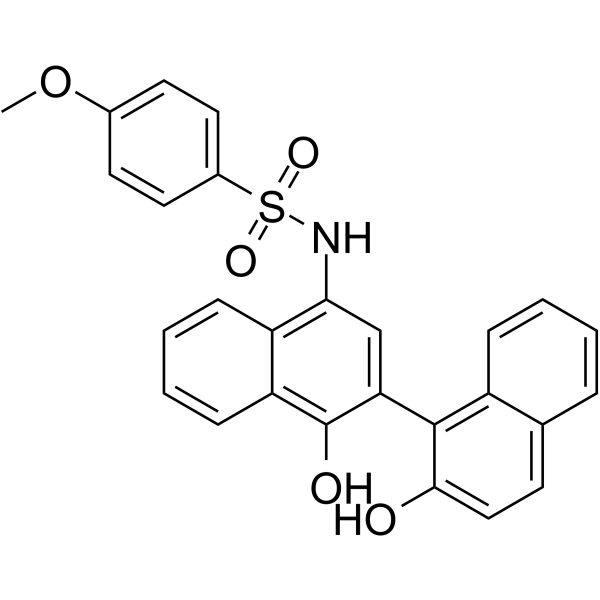
-
- HY-15611
-
|
|
CRM1
|
Cancer
|
|
KPT-185 is an orally bioavailable and selective inhibitor of CRM1 and displays potent antiproliferative properties at submicromolar concentrations (IC50=100-500 nM), induces apoptosis, cell-cycle arrest, and myeloid differentiation in AML cell lines and patient blasts .
|
-
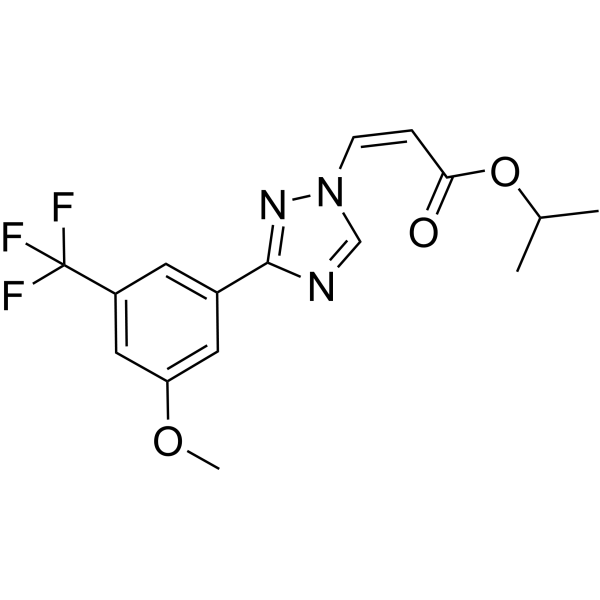
-
- HY-13680
-
|
Dian III; N-Methylisoindigotin; Natura-α
|
Apoptosis
|
Cancer
|
|
Meisoindigo (Dian III), a derivative of Indirubin (HY-N0117), halts the cell cycle at the G0/G1 phase and induces apoptosis in primary acute myeloid leukemia (AML) cells. Meisoindigo exhibits high antitumor activity .
|
-
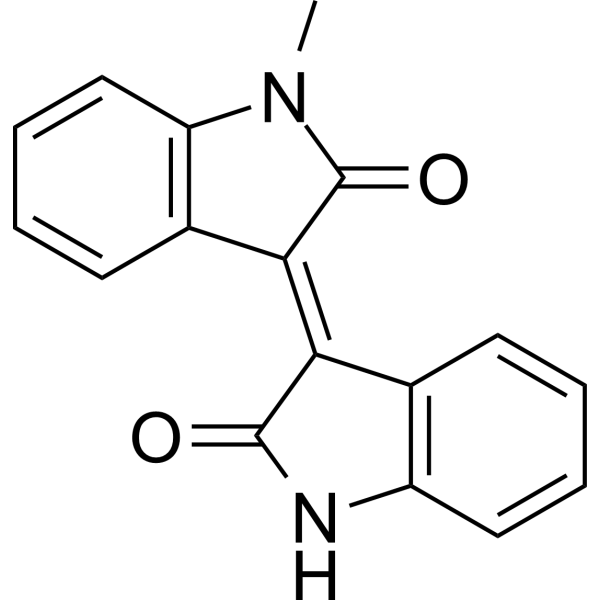
-
- HY-100548
-
GSK621
2 Publications Verification
|
AMPK
Autophagy
Apoptosis
|
Cancer
|
|
GSK621 is a specific AMPK activator, with IC50 values of 13-30 μM for AML cells. GSK621 induces autophagy and apoptosis. GSK621 induces eiF2α phosphorylation-a hallmark of UPR activation .
|
-
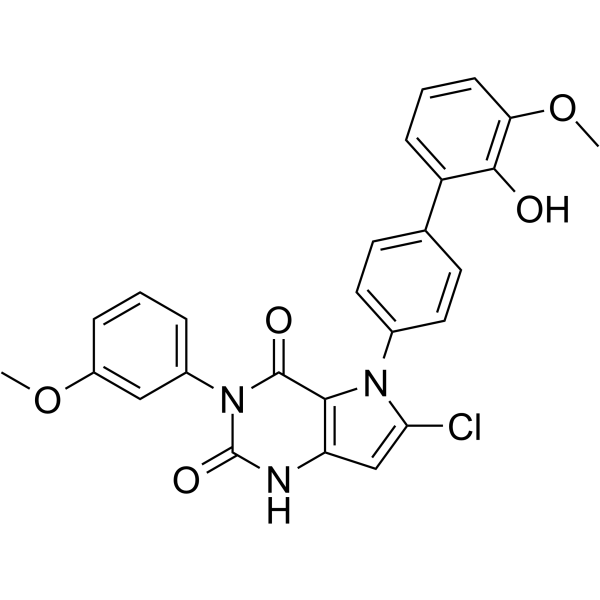
-
- HY-138831
-
|
|
HDAC
Apoptosis
|
Cancer
|
|
AES-350 is a potent and orally active HDAC6 inhibitor with an IC50 and a Ki of 0.0244 μM and 0.035 μM, respectively. AES-350 is also against HDAC3, HDAC8 in an enzymatic activity assay with IC50 values of 0.187 μM and 0.245 μM, respectively. AES-350 triggers apoptosis in AML cells through HDAC inhibition and can be used for acute myeloid leukemia (AML) research .
|
-
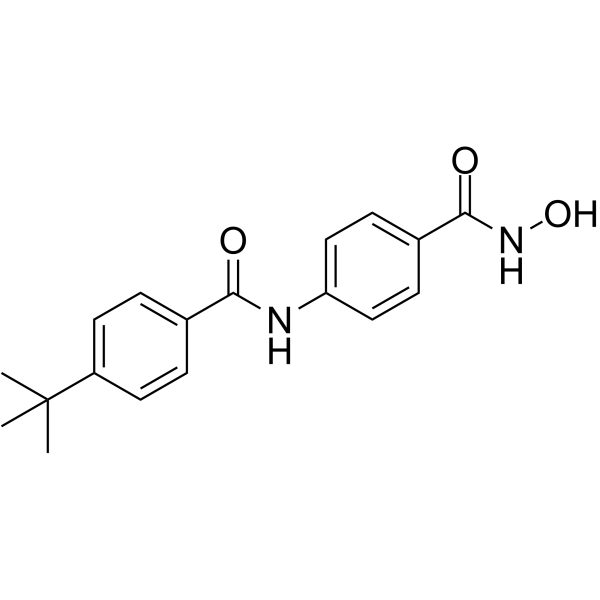
-
- HY-132231
-
|
|
PI3K
Apoptosis
|
Cancer
|
|
FD223 is a potent and selective phosphoinositide 3-kinase delta (PI3Kδ) inhibitor. FD223 displays high potency (IC50=1 nM) and good selectivity over other isoforms (IC50s of 51 nM, 29 nM and 37 nM, respectively for α, β and γ). FD223 exhibits efficient inhibition of the proliferation of acute myeloid leukemia (AML) cell lines by suppressing p-AKT Ser473 thus causing G1 phase arrest during the cell cycle. FD223 has potential for the research of leukemia such as AML .
|
-

-
- HY-134557
-
|
|
GSK-3
|
Cancer
|
|
GS87 is a highly specific and potent GSK3 inhibitor with IC50s of 415nM and 521nM for GSK3α and GSK3β, respectively. GS87 induces differentiation of acute myeloid leukemia (AML) cell lines by effectively activating GSK3-dependent signaling components including MAPK signaling. GS87 modulates key GSK3 target proteins involved in cell proliferation and differentiation more effectively than Lithium and SB415285 (SB). GS87 has the potential for acting as a differentiation agent for non-promyelocytic AML research .
|
-

-
- HY-142161
-
ABD957
1 Publications Verification
|
MAGL
|
Cancer
|
|
ABD957 is a potent and selective covalent inhibitor of the ABHD17 family of depalmitoylases, with an IC50 of 0.21 µM for ABHD17B. ABD957 can block N-Ras signaling and the growth of NRAS-mutant AML cells .
|
-
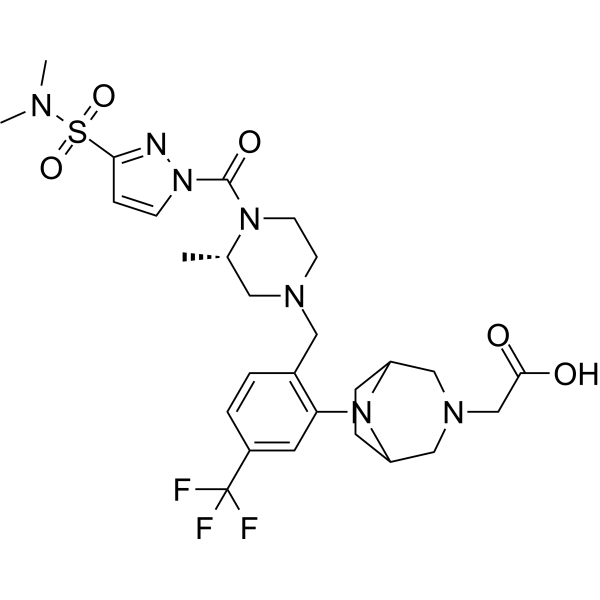
-
- HY-129079
-
|
|
Others
|
Cancer
|
|
TFMB-(R)-2-HG, a cell membrane-permeable version of (R)-2-HG, is a carcinogenic factor in Acute myeloid leukemia (AML).
TFMB-(R)-2-HG impairs SCF ER-Hoxb8 cells differentiation in response to estrogen withdrawal .
|
-
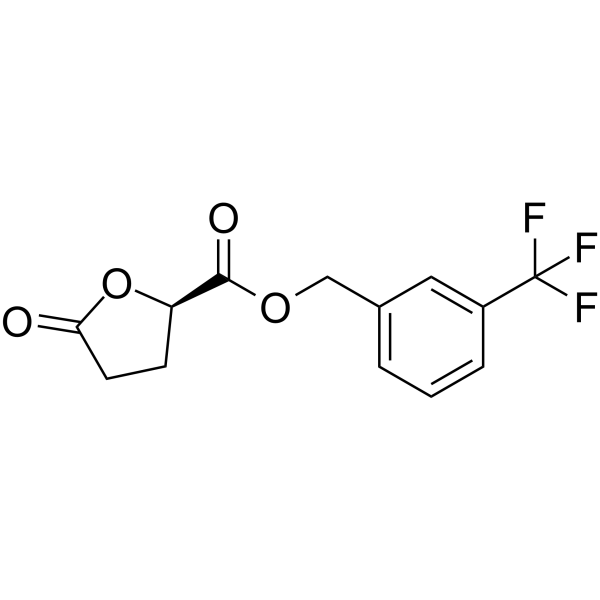
-
- HY-101266
-
|
DS-3032
|
MDM-2/p53
E1/E2/E3 Enzyme
Apoptosis
|
Cancer
|
|
Milademetan (DS-3032) is a specific and orally active MDM2 inhibitor for the research of acute myeloid leukemia (AML) or solid tumors. Milademetan (DS-3032) induces G1 cell cycle arrest, senescence and apoptosis .
|
-

-
- HY-101266B
-
|
DS-3032b; DS-3032 tosylate hydrate
|
MDM-2/p53
E1/E2/E3 Enzyme
Apoptosis
|
Cancer
|
|
Milademetan (DS-3032) tosylate hydrate is a specific and orally active MDM2 inhibitor for the research of acute myeloid leukemia (AML) or solid tumors. Milademetan (DS-3032) tosylate hydrate induces G1 cell cycle arrest, senescence and apoptosis .
|
-
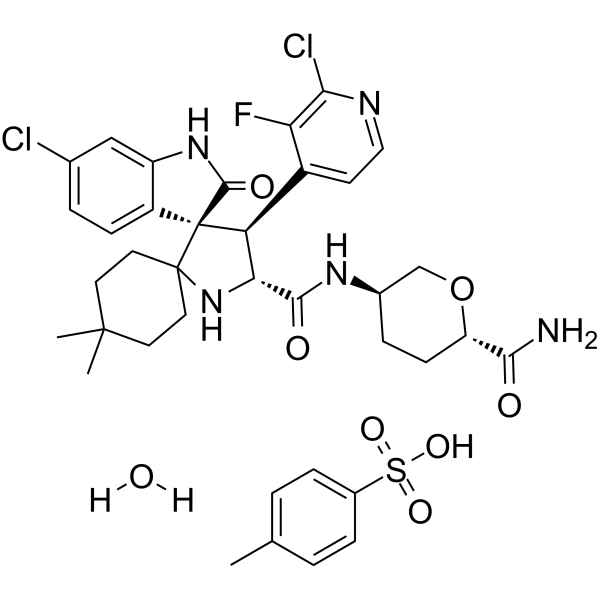
-
- HY-N10079
-
|
Jatrophan
|
SHP2
|
Cancer
|
|
Suchilactone (Jatrophan) is a lignan extracted from Monsonia angustifolia E.Mey. Suchilactone binds to SHP2 and inhibits SHP2 activation, thereby inhibiting ERK-mediated cell proliferation. Suchilactone can be ued in acute myeloid leukaemia (AML) .
|
-
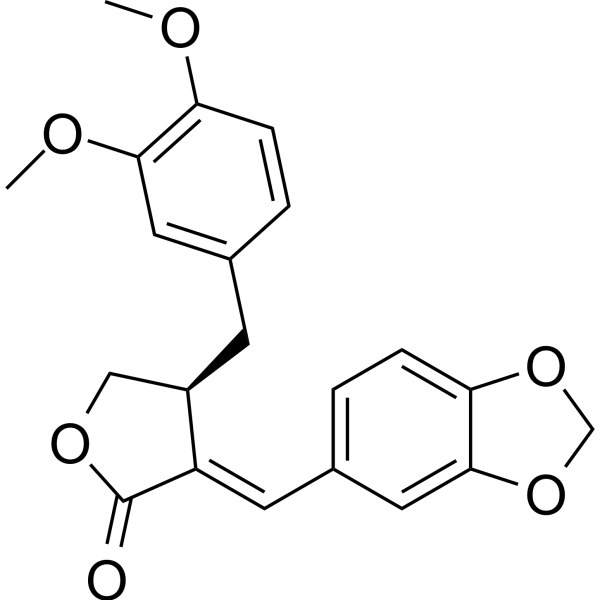
-
- HY-158341
-
|
|
HIF/HIF Prolyl-Hydroxylase
Apoptosis
|
Cancer
|
|
IOX5 is a selective prolyl hydroxylases (PHD) inhibitor. IOX5 stabilizes HIF-1α in AML cells, induces apoptosis, and upregulates BNIP3 expression. IOX5 compromises development and progression of acute myeloid leukemia .
|
-

-
- HY-147716
-
|
|
CDK
|
Cancer
|
|
CDK8-IN-6 (compound 9) is a potent cyclin-dependent kinase 8 (CDK8) inhibitor with an Kd of 13 nM. CDK8-IN-6 shows cytotoxicity for MOLM-13, OCI-AML3, MV4-11, NRK and H9c2 cells with IC50s of 11.2, 7.5, 8.6, 20.5, 12.5-25 µM, respectively. CDK8-IN-6 has the potential for the research of AML-cancer .
|
-

-
- HY-P99623
-
|
MGD006; S80880
|
CD3
|
Cancer
|
|
Flotetuzumab (MGD006; S80880) is an investigational CD123/CD3 bispecific dual-affinity retargeting antibody (DART) molecule. Flotetuzumab reactivates T cells by simultaneously binding to CD123 in target cells and CD3 in effector T cells, leading to T-cell-mediated cytotoxicity in target cells. Flotetuzumab shows inhibitory effect on a mouse model of patient-derived xenograft (PDX) in acute myeloid leukemia (AML) .
|
-

-
- HY-124629
-
|
|
Apoptosis
|
Cancer
|
|
DB2313 is a potent transcription factor PU.1 inhibitor with an apoptosis of 14 nM. DB2313 disrupts the interaction of PU.1 with target gene promoters. DB2313 induces apoptosis of acute myeloid leukemia (AML) cells, and has anticancer effects .
|
-
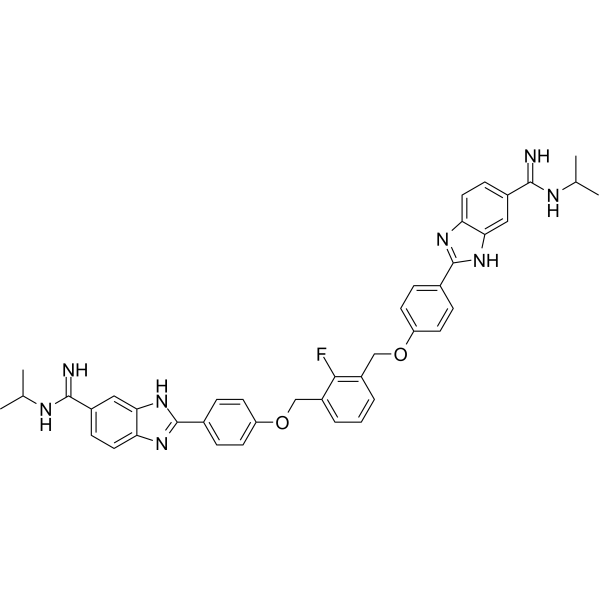
-
- HY-136688
-
|
|
PROTACs
|
Cancer
|
|
MI-389 is a PROTAC translation termination factor GSPT1 degrader. MI-389 disrupts a target that is a shared dependency in different AML and ALL cell lines, and that MI-389 action is dependent on the CRL4 CRBN E3 ligase .
|
-

-
- HY-112041
-
|
PTC596
|
Apoptosis
|
Cancer
|
|
Unesbulin (PTC596) is an orally active and selective B-cell-specific Moloney murine leukemia virus integration site 1 (BMI-1) inhibitor. Unesbulin downregulates MCL-1 and induces p53-independent mitochondrial apoptosis in acute myeloid leukemia (AML) cells. Unesbulin has anti-leukemic activity .
|
-
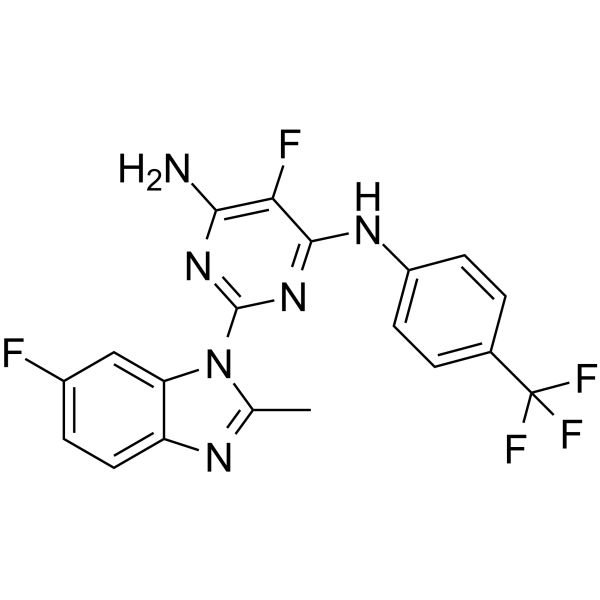
-
- HY-154997
-
|
|
METTL3
|
Cancer
|
|
7OQL (compound 54) is a selective METTL3 inhibitor (IC50=0.054 µM). 7OQL has the potential to be used in the study of cancer .
|
-
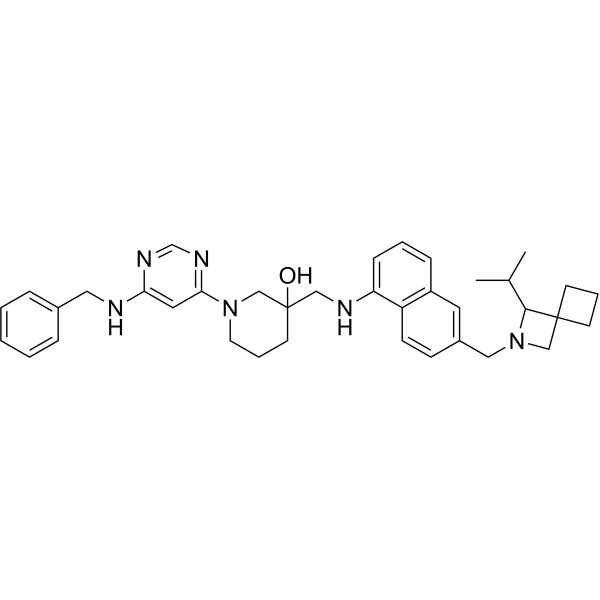
- HY-121725
-
|
|
STAT
|
Cancer
|
|
MM-206, a STAT3 activity inhibitor, potently inhibits the STAT3 SH2 domain-phosphopeptide interaction with IC50 of 1.2 μM. MM-206 demonstrates dose-dependent induction of apoptosis in acute myeloid leukemia (AML) cell lines .
|
-

- HY-147717
-
|
|
CDK
|
Cancer
|
|
CDK8-IN-7 (compound 12) is a potent and selective cyclin-dependent kinase 8 (CDK8) inhibitor with an Kd of 3.5 nM. CDK8-IN-7 shows cytotoxicity for MOLM-13, OCI-AML3, MV4-11, NRK and H9c2 cells with IC50s of 5.9, 4.8, 5.4, 16.2, 12.5-25 µM, respectively. CDK8-IN-7 has the potential for the research of AML-cancer .
|
-

- HY-P99014
-
|
|
Apoptosis
|
Inflammation/Immunology
|
|
Cusatuzumab is a human αCD70 monoclonal antibody. Cusatuzumab shows cytotoxicity activity with enhanced antibody-dependent cellular. Cusatuzumab reduces leukemia stem cells (LSCs) and triggers gene signatures related to myeloid differentiation and apoptosis. Cusatuzumab has the potential for the research of Acute myeloid leukemia (AML) .
|
-

- HY-153775
-
|
|
E1/E2/E3 Enzyme
|
Cancer
|
|
UC-764864 is a UBE2N inhibitor. UC-764864 inhibits UBE2N enzymatic activity. UC-764864 has cytotoxic effects and inhibition of UBE2N-dependent signaling in leukemic cells. UC-764864 blocks ubiquitination of innate immune- and inflammatory-related substrates in human AML cell lines .
|
-

- HY-160638
-
|
|
TET Protein
|
Cancer
|
|
NSC-311068 is TET1 inhibitor. NSC-311068 selectively suppress TET1 transcription and 5-hydroxymethylcytosine (5hmC) modification. NSC-311068 represses the level of TET1 expression and the global 5hmC level. NSC-311068 effectively inhibits cell viability in AML cells with high expression of TET1 .
|
-

- HY-136175
-
|
SNDX-5613
|
Epigenetic Reader Domain
|
Cancer
|
|
Revumenib (SNDX-5613) is a potent and specific Menin-MLL inhibitor with a binding Ki of 0.149 nM and a cell based IC50 of 10-20 nM. Revumenib can be used for the research of MLL-rearranged (MLL-r) acute leukemias, including acute lymphoblastic leukemia (ALL) and acute myeloid leukemia (AML) .
|
-
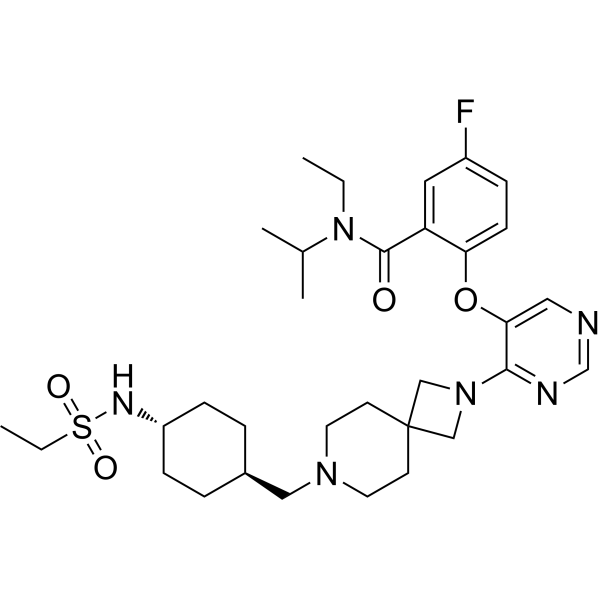
- HY-160415
-
|
|
PROTACs
Apoptosis
|
Cancer
|
|
WD6305 is a potent METTL3-targeted PROTAC degrader. WD6305 selectively reduces the METTL3 and METTL14 complex. WD6305 inhibits m 6A modification and the proliferation of AML cells and promotes apoptosis. WD6305 can be used for the research of leukemic .
|
-
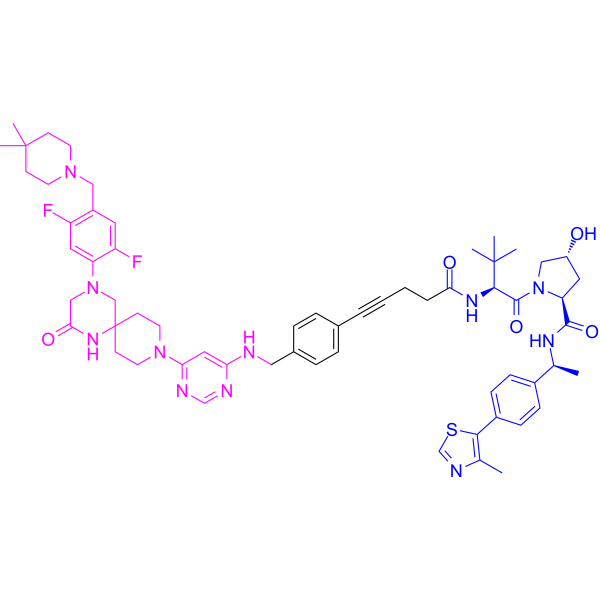
- HY-149474
-
|
|
FLT3
HDAC
Apoptosis
|
Cancer
|
|
HDAC-IN-63 (Compound 63) is a dual FLT3/HDAC inhibitor (IC50: 0.844 and 30.0 nM for FLT3 and HDAC1 respectively). HDAC-IN-63 inhibits MV4-11 cell proliferation (IC50: 92 nM. HDAC-IN-63 induces apoptosis and arrests cell cycle in MV4-11 cells. HDAC-IN-63 can be used for research of acute myeloid leukemia (AML) .
|
-
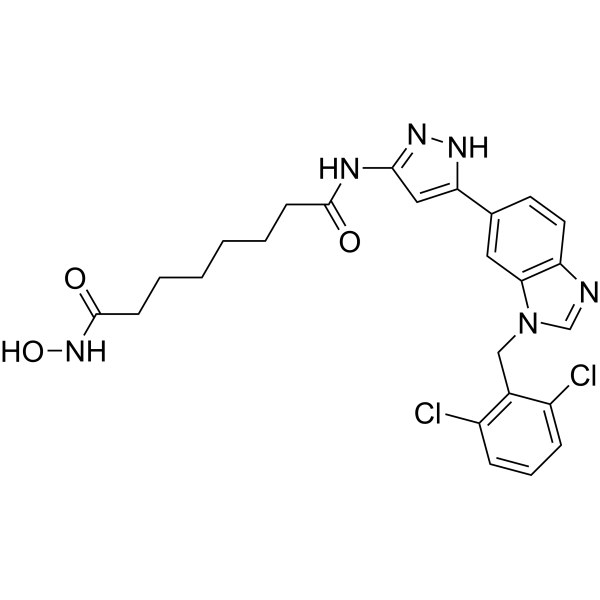
- HY-115881
-
|
|
PROTACs
|
Cancer
|
|
SR-1114 is a first-in-class PROTAC ENL degrader. SR-1114 elicits rapid, CRBN-dependent degradation of ENL with DC50s of 150 nM, 311 nM, and 1.65 μM in MV4;11 , MOLM-13, and OCI/AML-2 cells, respectively .
|
-

- HY-160415A
-
|
|
PROTACs
Apoptosis
|
Cancer
|
|
WD6305 TFA is a potent METTL3-targeted PROTAC degrader. WD6305 TFA selectively reduces the METTL3 and METTL14 complex. WD6305 TFA inhibits m 6A modification and the proliferation of AML cells and promotes apoptosis. WD6305 TFA can be used for the research of leukemic .
|
-
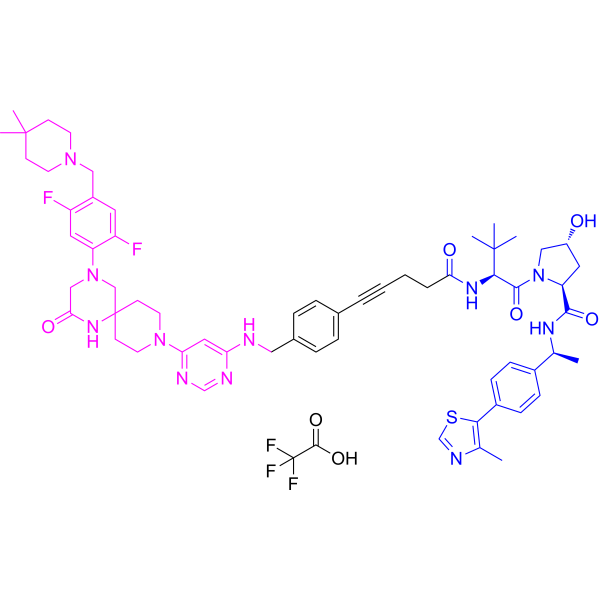
- HY-149735
-
|
|
Epigenetic Reader Domain
Apoptosis
|
Cancer
|
|
BET-IN-20 (compound 10) is an inhibitor of BRD4 BD1 (IC50=1.9 nM) with anticancer activity. BET-IN-20 can promote acute myeloid leukemia (AML) cell apoptosis and arrest the cell cycle in the G0/G1 phase. BET-IN-20 also inhibits c-Myc and CDK6 and enhances PARP cleavage .
|
-

- HY-104072
-
-

- HY-112852A
-
|
|
Src
Apoptosis
|
Cancer
|
|
TL02-59 dihydrochloride is an orally active, selective Src-family kinase Fgr inhibitor with an IC50 of 0.03 nM. TL02-59 dihydrochloride inhibits Lyn and Hck with IC50s of 0.1 nM and 160 nM, respectively. TL02-59 dihydrochloride potently suppresses acute myelogenous leukemia (AML) cell growth .
|
-

- HY-112852
-
TL02-59
4 Publications Verification
|
Src
Apoptosis
|
Cancer
|
|
TL02-59 is an orally active, selective Src-family kinase Fgr inhibitor with an IC50 of 0.03 nM. TL02-59 inhibits Lyn and Hck with IC50s of 0.1 nM and 160 nM, respectively. TL02-59 potently suppresses acute myelogenous leukemia (AML) cell growth .
|
-
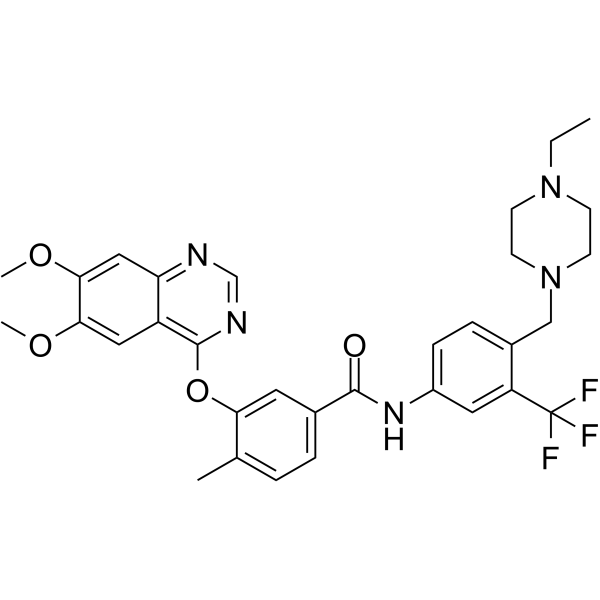
- HY-144675
-
|
|
Histone Demethylase
|
Cancer
|
|
LSD1-IN-13 (compound 7e) is an orally active and potent LSD1 inhibitor, with an IC50 of 24.43 nM. LSD1-IN-13 can activate CD86 expression, with an EC50 of 470 nM. LSD1-IN-13 induces differentiation of AML (acute myeloid leukemia) cell lines .
|
-
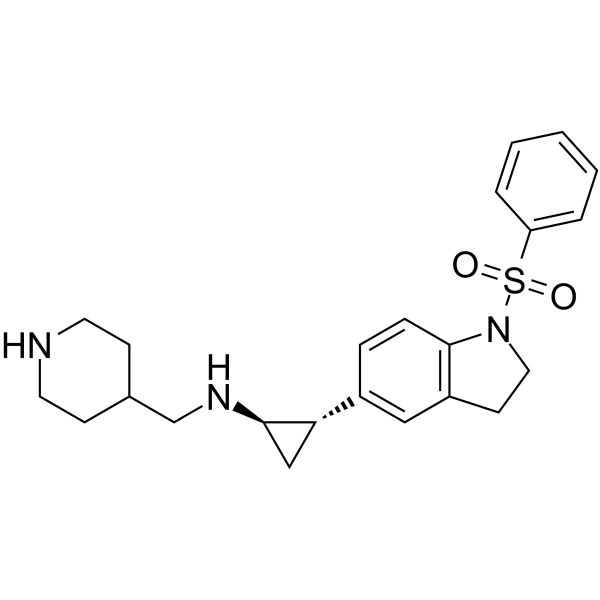
- HY-144675A
-
|
|
Histone Demethylase
|
Cancer
|
|
LSD1-IN-13 hydrochloride (compound 7e) is an orally active and potent LSD1 inhibitor, with an IC50 of 24.43 nM. LSD1-IN-13 hydrochloride can activate CD86 expression, with an EC50 of 470 nM. LSD1-IN-13 hydrochloride induces differentiation of AML (acute myeloid leukemia) cell lines .
|
-
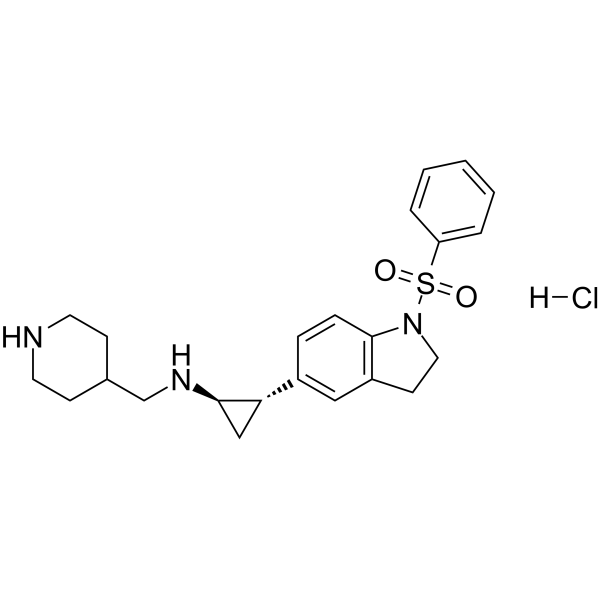
- HY-151381
-
|
|
Dihydroorotate Dehydrogenase
|
Cancer
|
|
hDHODH-IN-10 is a selective, potent and orally active hDHODH inhibitor, with an IC50 value of 10.9 nM. hDHODH-IN-10 forms hydrogen bonds with key residues Arg136 and Gln47. hDHODH-IN-10 inhibits the proliferation of cancer cells. hDHODH-IN-10 can be used in the research of cancers, such as AML, colorectal cancer .
|
-
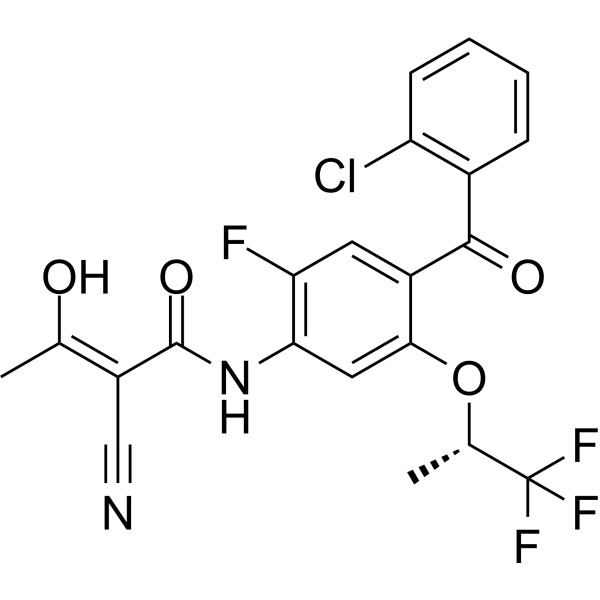
- HY-163160
-
|
|
Apoptosis
Epigenetic Reader Domain
|
Cancer
|
|
Bet-in-23 (Compound 23) is a BD2-selective BET inhibitor with an IC50 of 2.9 nM. BET-IN-23 has anticancer activity and can significantly inhibit the proliferation of acute myeloid leukemia (AML) cell lines by inducing G0/G1 arrest and apoptosis in vitro .
|
-
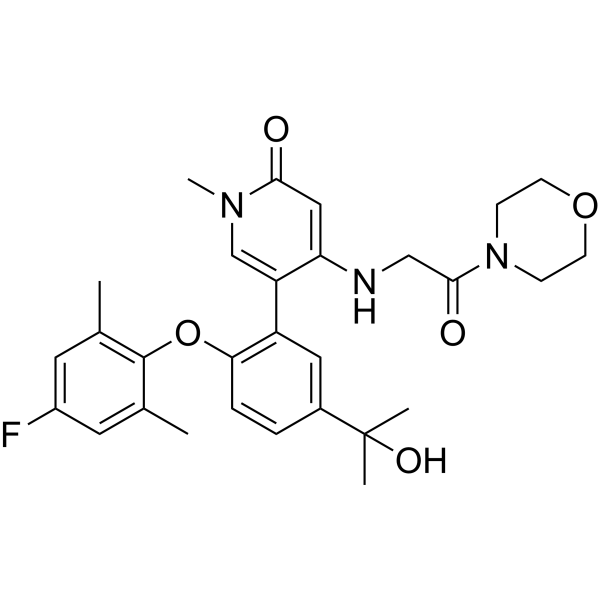
- HY-162250
-
|
|
PROTACs
Histone Methyltransferase
|
Cancer
|
|
MS8847 is a highly potent EZH2 PROTAC degrader that recruits the E3 ligase von Hippel-Lindau (VHL). MS8847 potently degrades EZH2 in a ubiquitin-proteasome system-dependent manner. MS8847 effectively inhibits the growth of acute myeloid leukemia (AML) and triple-negative breast cancer (TNBC) cells .
|
-

- HY-139193
-
|
|
Others
|
Cancer
|
|
TH1760 is an inhibitor of NUDIX-type 15 (NUDT15) with an IC50 value of 25 nM. TH1760 sensitizes cells to 6-thioguanine by enhancing the accumulation of 6-thio- (d) GTP in nucleic acids. TH1760 enhances the anti-leukemia effect of thiopurine .
|
-
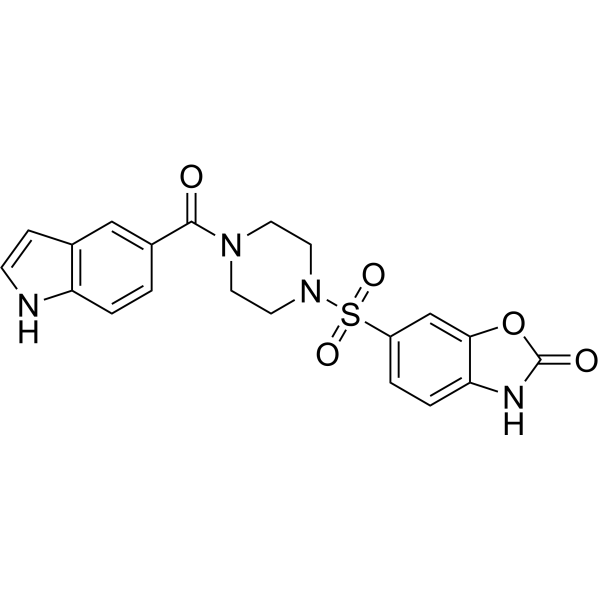
- HY-162293
-
|
|
CDK
|
Cancer
|
|
CDK8-IN-14 (compound 12) inhibits CDK8 with an IC50 value of 39.2 nM and has anti-AML cell proliferation activity (molm-13 GC50 = 0.02±0.01μM, MV4-11 GC50 = 0.03±0.01μM) .
|
-
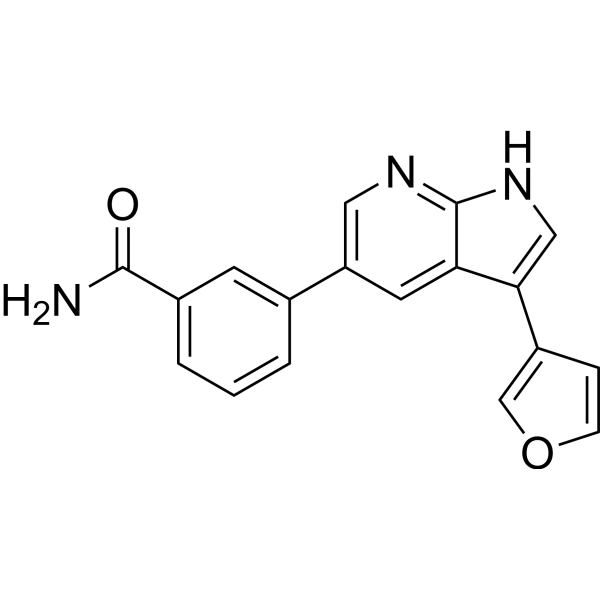
- HY-115906
-
|
|
FLT3
MNK
Apoptosis
|
Cancer
|
|
K783-0308 is a potent and selective dual inhibitor of FLT3 and MNK2 with IC50 values of 680 and 406 nM, respectively. K783-0308 inhibits the growth of MOLM-13 (IC50=10.5 µM) and MV-4-11 (IC50=10.4 µM) cells. K783-0308 promotes acute myeloid leukemia (AML) cell apoptosis and cell cycle arrests in the G0/G1 phase .
|
-

- HY-150797
-
|
QA-68-ZU81
|
Epigenetic Reader Domain
|
Inflammation/Immunology
Cancer
|
|
QA-68 (QA-68-ZU81) is a potent bromodomain-containing protein 9 (BRD9) degrader. QA-68 can inhibit cell cycle progression and cell colony formation. QA-68 has antiproliferative activity against acute myeloid leukemia (AML) cell lines . QA-68 is a click chemistry reagent, it contains an Alkyne group and can undergo copper-catalyzed azide-alkyne cycloaddition (CuAAc) with molecules containing Azide groups.
|
-

- HY-161280
-
|
|
PROTACs
FLT3
|
Cancer
|
|
PROTAC FLT-3 degrader 3 (compound 35) is a PROTACs degrader of FLT. PROTAC FLT-3 degrader 3 has antiproliferative activity, with IC50 of 7.55 nM in MV4-11 cells .
|
-
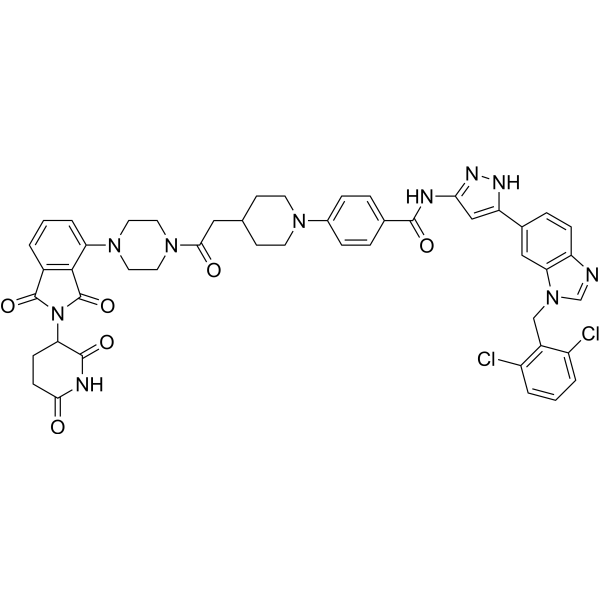
- HY-162282
-
|
|
DNA Methyltransferase
|
Cancer
|
|
PROTAC METTL3-14 degrader 1 (compound 30) is a PROTAC degrader of METTL3-14. PROTAC METTL3-14 degrader 1 shows a 50% or higher degradation of METTL3 and/or METTL14 .
|
-
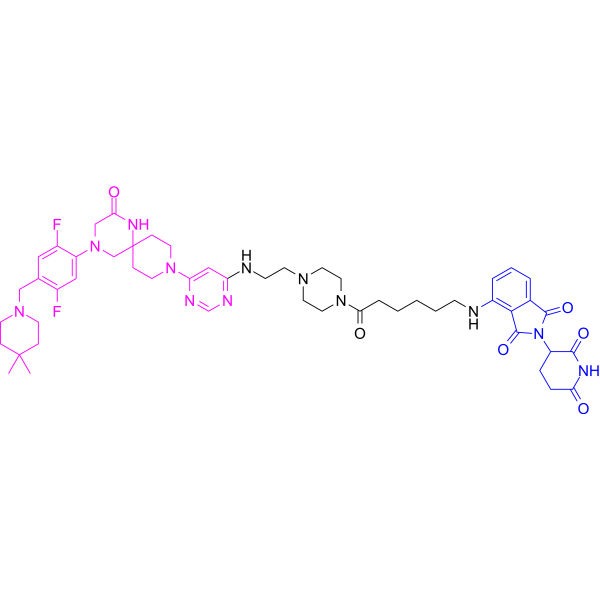
- HY-158160
-
|
|
Sodium Channel
|
Metabolic Disease
|
|
LBA-3 is a selective, orally active inhibitor for sodium-coupled citrate transporter SLC13A5, with an IC50 of 67 nM. LBA-3 decreases levels of triglyceride and total cholesterol in oleic and palmitic acid (OPA)-stimulated AML12 cells, PCN-stimulated primary mouse hepatocytes and in mouse models, without detectable toxicity. LBA-3 is blood-brain barrier permeable .
|
-

- HY-P99394
-
|
JNJ-64407564
|
CD3
|
Cancer
|
|
Talquetamab (JNJ-64407564) is a humanized bispecific antibody that binds to GPRC5D (member of G protein-coupled receptor family C5 group D) and CD3 to induce T cell-mediated killing of GPRC5D-expressing MM cells through T cell recruitment and activation. Talquetamab (JNJ-64407564) has antitumor activity .
|
-

- HY-122209
-
|
|
HBV
|
Infection
|
|
DVR-01 is a HBV inhibitor with EC50 values of 1.7 and 1.6 μM in AML12HBV10 and HepDES19 cells, respectively. DVR-01 shows antiviral activity against drug-resistant HBV mutants with EC50s of 2.403-3.273 μM. DVR-01 can be used for the research of HBV infection and related diseases .
|
-
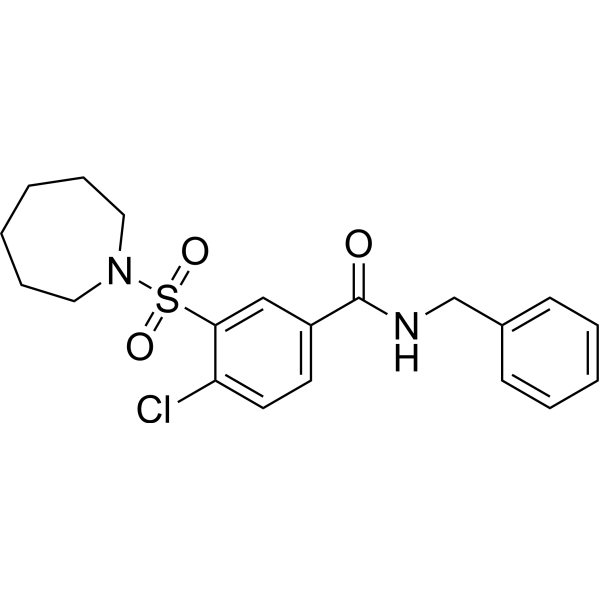
- HY-155175
-
|
|
Tim3
|
Cancer
|
|
TIM-3-IN-2 (Compound A-41) is a Tim3 inhibitor (KD: 0.61 μM). TIM-3-IN-2 blocks TIM-3 interactions with PtdSer, CEACAM1, and Gal-9. TIM-3-IN-2 inhibits the immunosuppressive function of TIM-3. TIM-3-IN-2 reverses the TIM-3-mediated blockade of the production of proinflammatory cytokines, and maximizes the T-cell antitumor activity against AML cell lines .
|
-

- HY-148522
-
|
|
FLT3
|
Cancer
|
|
FLT3-IN-18 is a potent and selective FLT3 inhibitor with an IC50 value of 0.003 μM. FLT3-IN-18 induces apoptosis and cell cycle arrest at G1 phase. FLT3-IN-18 inhibits FLT3 and STAT5 phosphorylation. FLT3-IN-18 has the potential for the research of acute myeloid leukemia (AML) .
|
-
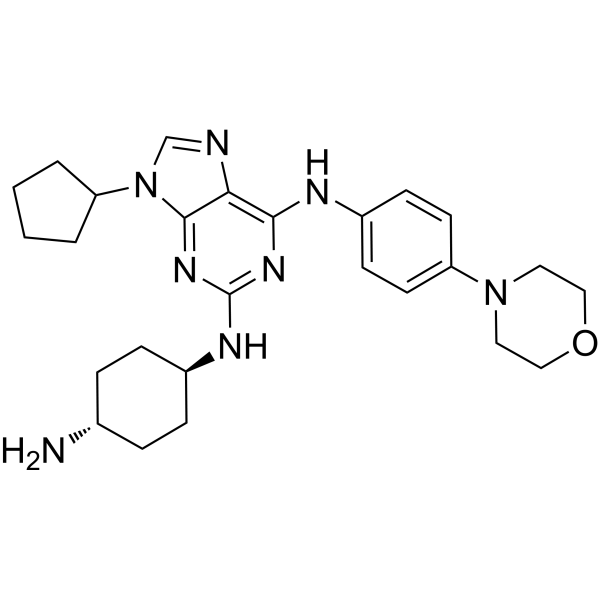
- HY-125236
-
|
|
Epigenetic Reader Domain
|
Cancer
|
|
BET-IN-19 (Compound 146) is a BET inhibitor. BET-IN-19 inhibits hlL-6 mRNA transcription (IC50 ≤ 0.3 uM), and c-myc activity in human AML MV4-11 cell (IC50 ≤ 0.3 uM)。BET-IN-19 inhibits tetra-acetylated histone H4 binding to BRD4 bromodomain 1 (IC50 ≤ 0.3 uM) .
|
-

- HY-124500
-
|
|
STAT
Apoptosis
|
Cancer
|
|
AC-4-130 is a potent STAT5 SH2 domain inhibitor. AC-4-130 directly binds to STAT5 and disrupts STAT5 activation, dimerization, nuclear translocation, and STAT5-dependent gene transcription. AC-4-130 induces cell cycle arrest and apoptosis in FLT3-ITD-driven leukemic cells. AC-4-130 has anti-cancer activity and can efficiently block pathological levels of STAT5 activity in acute myeloid leukemia (AML) .
|
-

- HY-155529
-
|
|
Pim
|
Cancer
|
|
FD1024 is PIM inhibitor (IC50s: 1.96, 38.9, 4.17 nM for PIM1, 2, 3). FD1024 can be used for research of acute myeloid leukemia. FD1024 has strong antiproliferative activity against the tested AML cell lines, with 0.16 μM, 0.12 μM, 1.05 μM, 1.39μM for EOL-1, MV-4-11, KG-1, MOLM-16 cells. FD1024 also has antitumor efficacy in mice .
|
-
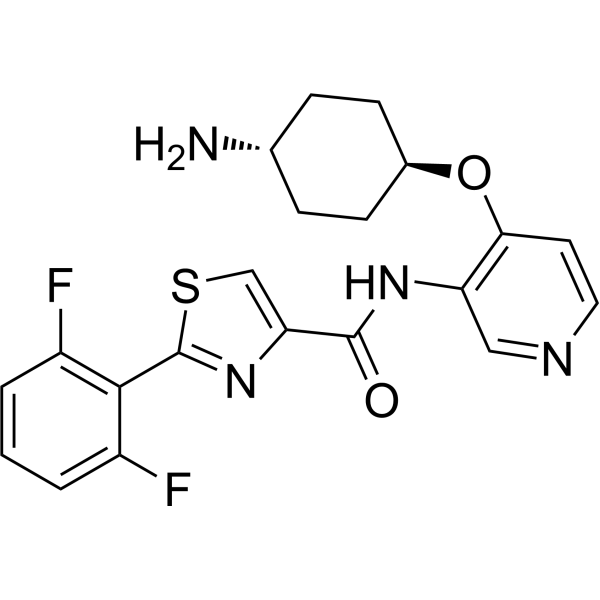
- HY-155226
-
|
|
FLT3
Apoptosis
|
Cancer
|
|
FLT3-IN-21 (compound LC-3) is a potent FLT3 inhibitor (IC50: 8.4 nM) and induces apoptosis. FLT3-IN-21 can arrest the cell cycle in the G1 phase and inhibit the proliferation of FLT3-ITD-positive AML cells MV-4-11 (IC50: 5.3 nM). In mice, FLT3-IN-21 (10 mg/kg/d) inhibited tumor growth in the MV-4-11 xenograft model (TGI=92.16%) .
|
-
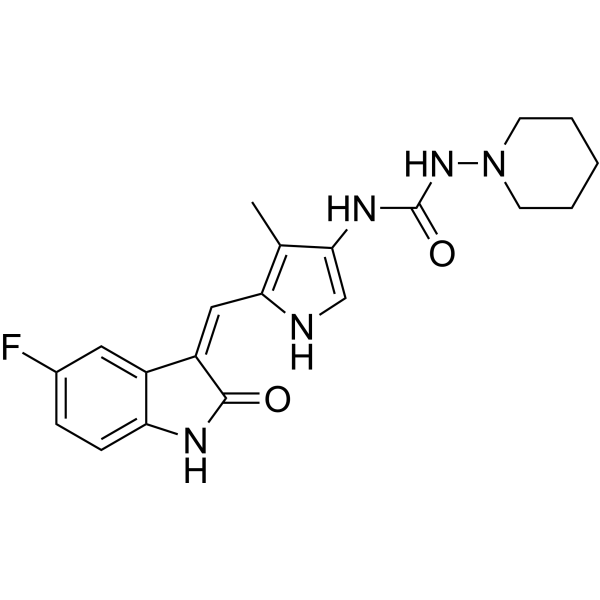
- HY-158325
-
|
|
PROTACs
FLT3
Apoptosis
|
Cancer
|
|
PROTAC FLT-3 degrader 4 is an orally active CRBN-based FLT3-PROTAC degrader that potently induces FLT3-ITD degradation through the ubiquitin-proteasome system. PROTAC FLT-3 degrader 4 shows highly selective to FLT3-ITD mutant acute myeloid leukemia (AML) cells. (Blue: CRBN ligand, Black: linker; Pink: FLT3 inhibitor) .
|
-

- HY-12344A
-
|
|
FLT3
|
Cancer
|
|
UNC2025 hydrochloride is a potent, ATP-competitive, and highly orally active Mer/Flt3 inhibitor with IC50 values of 0.74 nM and 0.8 nM, respectively. UNC2025 hydrochloride is >45-fold selectivity for MERTK relative to Axl (IC50= 122 nM; Ki = 13.3 nM). UNC2025 hydrochloride exhibits an excellent PK properties, and can be used for the investigation of acute leukemia .
|
-
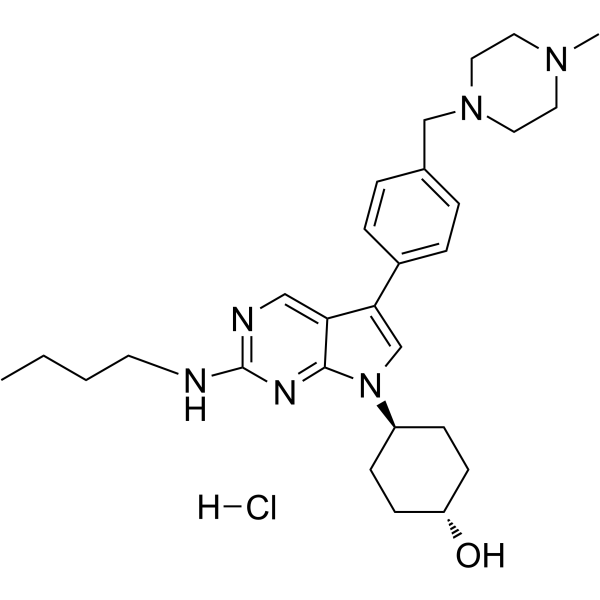
- HY-155112
-
|
|
Microtubule/Tubulin
FLT3
Bcr-Abl
|
Cancer
|
|
Antiproliferative agent-30 (Compound 8g) inhibits tubulin assembly and inhibits FLT3 and Abl1. Antiproliferative agent-30 has vascular-disrupting activity. Antiproliferative agent-30 has broad antiproliferative activities against cancer cell lines (IC50s: 0.054 nM, 0.008 nM, 0.144 nM for HCT-116, K562, MV-4-11 cells respectively). Antiproliferative agent-30 also has anticancer effect against AML with FLT3-ITD-TKD mutation .
|
-
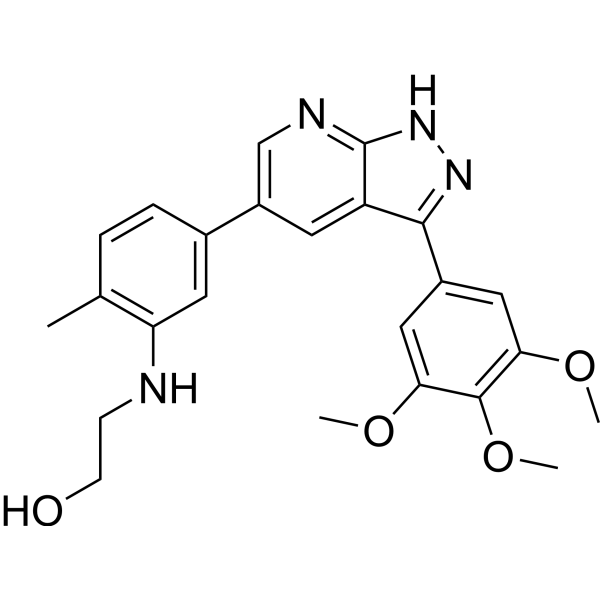
- HY-108417
-
|
|
STAT
JAK
Bcr-Abl
|
Cancer
|
|
Debio 0617B, a multi-kinase inhibitor, reduces maintenance and self-renewal of primary human AML CD34 + stem/progenitor cells. Debio 0617B has a unique profile targeting key kinases upstream of STAT3/STAT5 signaling such as JAK, SRC, ABL, and class III/V receptor tyrosine kinases (TKs). Debio 0617B has documented efficacy in STAT3-driven solid tumors .
|
-
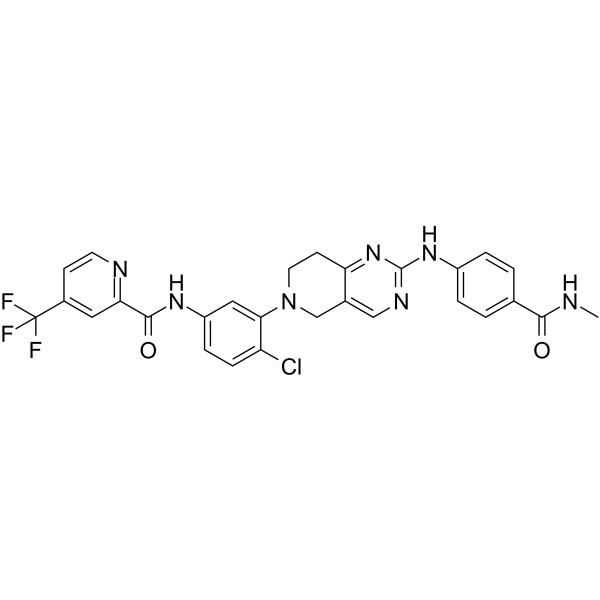
- HY-114414
-
|
|
HDAC
mTOR
Apoptosis
|
Cancer
|
|
HDACs/mTOR Inhibitor 1 is a dual HDACs and mTOR inhibitor, with IC50s of 0.19 nM, 1.8 nM, 1.2 nM for HDAC1, HDAC6, mTOR, respectively. HDACs/mTOR Inhibitor 1 stimulates cell cycle arrest in G0/G1 phase and induces tumor cell apoptosis with low toxicity in vivo. HDACs/mTOR Inhibitor 1 can be used in the research of hematologic malignancies .
|
-

- HY-129937A
-
|
|
PROTACs
Epigenetic Reader Domain
|
Cancer
|
|
GNE-987 is a PROTAC connected by ligands for von Hippel-Lindau and BRD4. GNE-987 exhibits picomolar cell BRD4 degradation activity (DC50=0.03 nM for EOL-1 AML cell line). GNE-987 binds equipotently to the BD1 and BD2 bromodomains of BRD4 with low nanomolar affinities (IC50=4.7 and 4.4 nM, respectively). GNE-987 incorporates a potent BET binder/inhibitor, a VHL-binding fragment, and a ten methylene spacer moiety. GNE-987 can be used in PROTAC-Antibody Conjugate (PAC) .
|
-
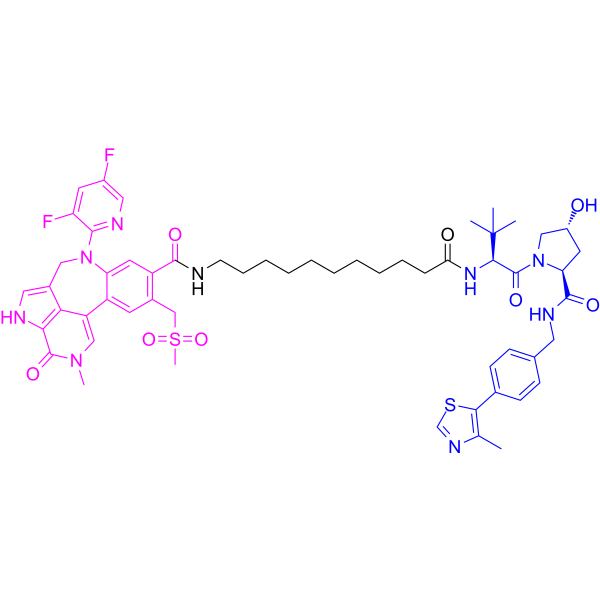
- HY-143317
-
|
|
Epigenetic Reader Domain
|
Cancer
|
|
XY153 (compound 8l) is a BD2-selective BET inhibitor and selectively binds to BRD4 BD2. XY153 binds to BRD4 BD2, BRD3 BD2 and BRD2 BD2 with IC50s of 0.79, 5.31 and 5.09 nM, respectively. XY153 shows potent antiproliferative activity against multiple tumor cell lines. XY153 can be used for the research of acute myeloid leukemia (AML) and cancer .
|
-
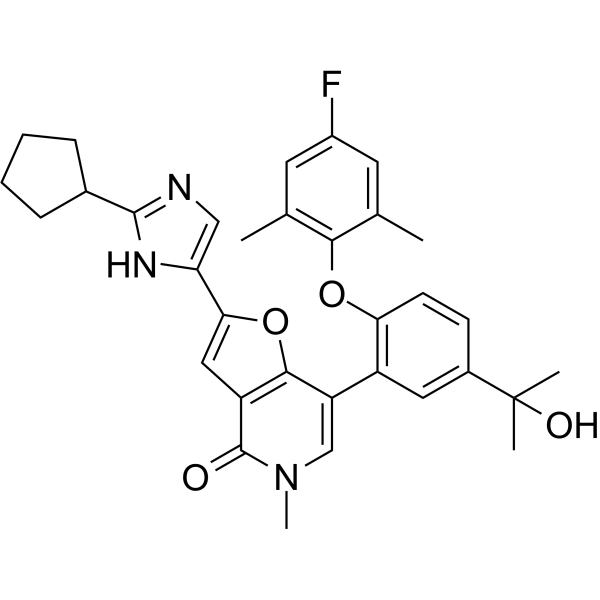
- HY-118304
-
|
|
FLT3
Apoptosis
Caspase
|
Cancer
|
|
AKN-028, a novel tyrosine kinase (TK) inhibitor, is a potent, orally active FMS-like receptor tyrosine kinase 3 (FLT3) inhibitor with an IC50 value of 6 nM. AKN-028 inhibits FLT3 autophosphorylation. AKN-028 induces dose-dependent cytotoxic response (mean IC50=1 μM). AKN-028 induces apoptosisby activation of caspase 3. AKN-028 can be used in research of acute myeloid leukemia (AML) .
|
-
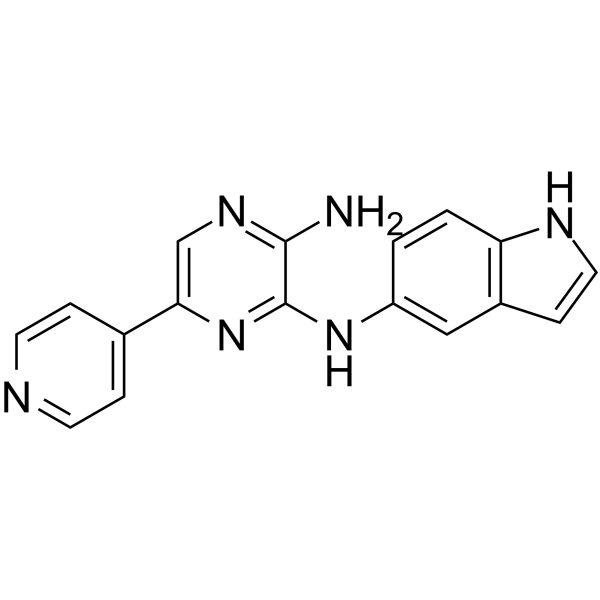
- HY-111447
-
|
|
NADPH Oxidase
Apoptosis
|
Cardiovascular Disease
Cancer
|
|
VAS 3947, a specific NADPH oxidase (NOX) inhibitor, exerts a potent antiplatelet effect. VAS3947 induces apoptosis independently of anti-NOX activity, via UPR activation, mainly due to aggregation and misfolding of proteins .
|
-

- HY-118304B
-
|
|
FLT3
Apoptosis
Caspase
|
Cancer
|
|
AKN-028 acetate, a novel tyrosine kinase (TK) inhibitor, is a potent, orally active FMS-like receptor tyrosine kinase 3 (FLT3) inhibitor with an IC50 value of 6 nM. AKN-028 acetate inhibits FLT3 autophosphorylation. AKN-028 acetate induces dose-dependent cytotoxic response (mean IC50=1 μM). AKN-028 acetate induces apoptosisby activation of caspase 3. AKN-028 acetate can be used in research of acute myeloid leukemia (AML).
|
-

- HY-139996
-
|
|
PROTACs
Ligands for E3 Ligase
|
Cancer
|
|
Pomalidomide-C5-Dovitinib (compound 2) is a PROTAC containing Pomalidomide, Dovitinib and connected with CRBN. Pomalidomide-C5-Dovitinib shows enhanced antiproliferative effects against FLT3-ITD+ AML cells. Pomalidomide-C5-Dovitinib induces the degradation of the FLT3-ITD and KIT proteins in a ubiquitin-proteasome-dependent manner and completely blocks their downstream signaling pathway. Pomalidomide-C5-Dovitinib has the potential for the research of FLT3-ITD + acute myeloid leukemia .
|
-
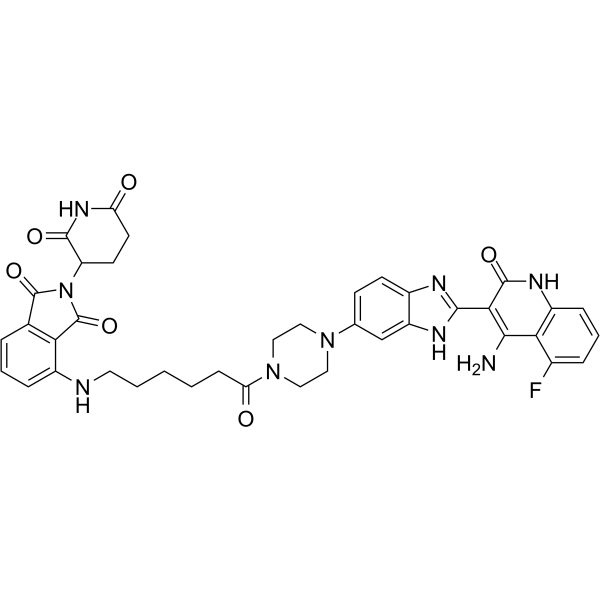
- HY-143894
-
|
|
FLT3
|
Cancer
|
|
FLT3-IN-11 (compound 30) is a potent, selective and orally active FLT3 kinase inhibitor with IC50s of 7.22 nM and 4.95 nM for wild-type FLT3 and FLT3-D835Y, respectively. FLT3-IN-11 high selectivity for FLT3 over c-KIT (>1000-fold). FLT3-IN-11has excellent anti-acute myeloid leukemia (AML) activity (MV4-11 cells, IC50 of 3.2 nM) .
|
-
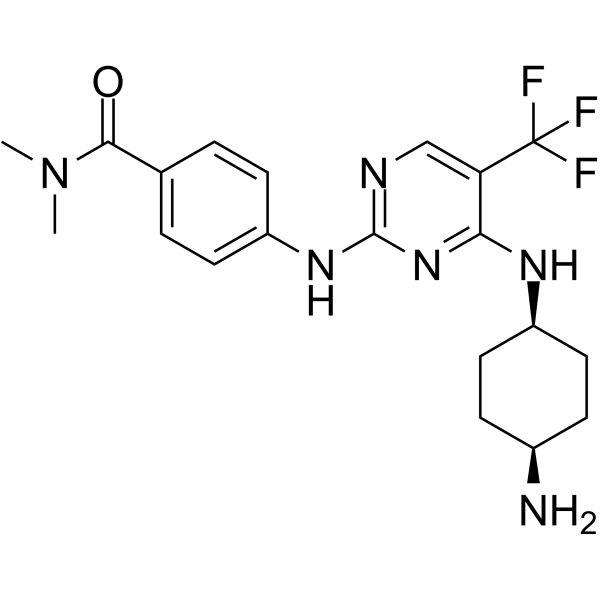
- HY-P99395
-
|
JNJ 56022473; CSL 362
|
Interleukin Related
|
Cancer
|
|
Talacotuzumab (JNJ 56022473; CSL 362) is an IgG1-type fully humanized, CD123-neutralizing monoclonal antibody containing a modified Fc structure. Talacotuzumab has KDs of 0.43 nM, 188 nM, 46 nM, 16.8 nM for CD123, CD32b/c, CD16-158F, CD16-158V, respectively. Talacotuzumab inhibits IL-3 binding to CD123, antagonizing IL-3 signaling in target cells. Talacotuzumab has mutated the Fc region to increase affinity for CD16 (FcγRIIIa), thereby enhancing antibody-dependent cell-mediated cytotoxicity (ADCC). Talacotuzumab is highly effective in vivo reducing leukemic cell growth in acute myeloid leukemia (AML) xenograft mouse models .
|
-

- HY-155066
-
|
|
PI3K
mTOR
|
Cancer
|
|
FD274 is a highly potent PI3K/mTOR dual inhibitor with IC50s of 0.65 nM, 1.57 nM, 0.65 nM, 0.42 nM, and 2.03 nM against PI3Kα/β/γ/δ and mTOR, respectively. FD274 exhibits significant anti-proliferation of AML cell lines (HL-60 and MOLM-16). FD274 demonstrates dose-dependent inhibition of tumor growth in the HL-60 xenograft model. FD274 has the potential for acute myeloid leukemia research .
|
-
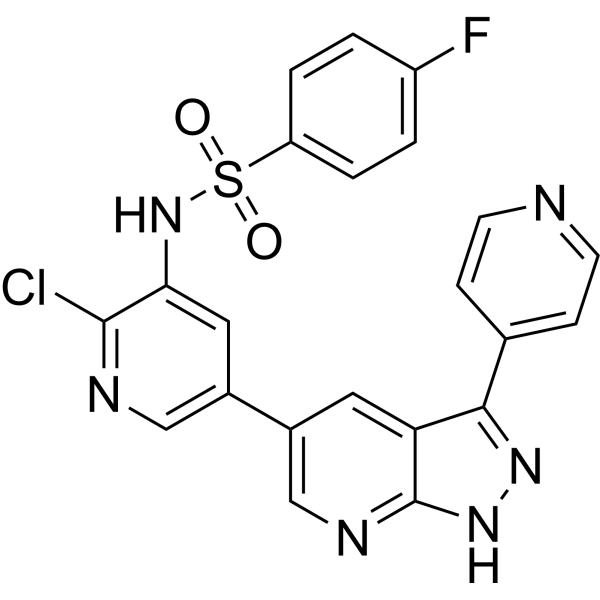
- HY-128724
-
|
|
p97
|
Cancer
|
|
CB-5339 is an oral activity potent p97 inhibitor with an IC50 <30 nM. CB-5339 can be used for leukemia research . CB-5339 extracted from WO2015109285A1 compound FF07.
|
-

- HY-149359
-
|
|
Isocitrate Dehydrogenase (IDH)
|
Cancer
|
|
IHMT-IDH1-053 (compound 16) is a highly selectivity and irreversible IDH1-mutant inhibitor with an IC50 of 4.7 nM for IDH1 R132H. IHMT-IDH1-053 displays high selectivity against IDH1 mutants over IDH1 wt and IDH2 wt/mutants. IHMT-IDH1-053 inhibits 2-hydroxyglutarate (2-HG) production in IDH1 R132H mutant transfected 293T cells (IC50=28 nM). IHMT-IDH1-053 binds to the IDH1 R132H protein in the allosteric pocket adjacent to the NAPDH binding pocket through a covalent bond with residue Cys269. IHMT-IDH1-053 inhibits the proliferation of HT1080 cell line and primary AML cells which both bear IDH1 R132 mutants .
|
-

- HY-146749
-
|
|
FLT3
Trk Receptor
Apoptosis
|
Cancer
|
|
FLT3/TrKA-IN-1 is a potent FLT3/TrKA dual kinase inhibitor with the IC50s of 43.8 nM, 97.2 nM, 92.5 nM and 23.6 nM for FLT3, FLT3-ITD, FLT3-TKD and TrKA, respectively. FLT3/TrKA-IN-1 induces cell cycle arrest at the G0/G1 phase as well as apoptosis and shows antiproliferative activity in vitro. FLT3/TrKA-IN-1 has the potential for the research of Acute myeloid leukemia (AML) .
|
-
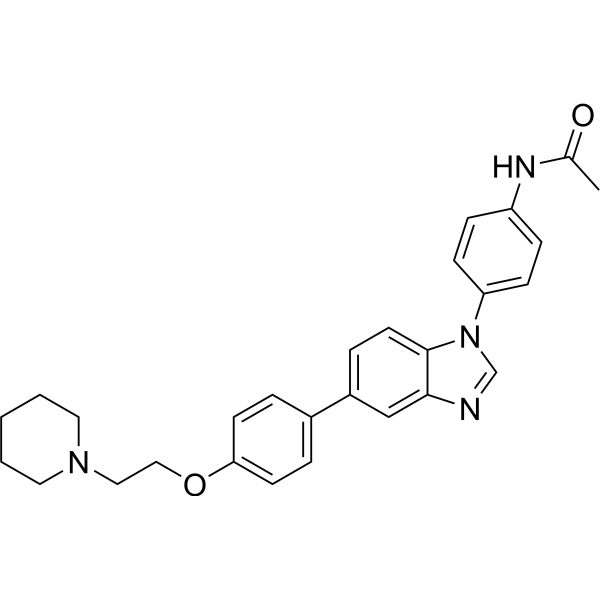
- HY-128888B
-
|
|
Isocitrate Dehydrogenase (IDH)
|
Cancer
|
|
(S,R)-GSK321 is a potent, selective mutant IDH1 inhibitor with IC50 values of 2.9, 3.8, 4.6 and 46 nM for R132G, R132C, R132H and WT IDH1, respectively, and >100-fold selectivity over IDH2. (S,R)-GSK321 induces decrease in intracellular 2-HG, abrogation of the myeloid differentiation block and induction of granulocytic differentiation at the level of leukemic blasts and more immature stem-like cells. (S,R)-GSK321can be used for research of acute myeloid leukemia (AML) and other cancers .
|
-

- HY-155770
-
|
|
FLT3
|
Cancer
|
|
FLT3-IN-20 (compound 34f) is a potent FLT3 inhibitor with IC50 values of 1 and 4 nM for FLT3-D835Y and FLT3-ITD, respectively. FLT3-IN-20 has anti-proliferation efficacy in FLT3-ITD-positive AML cell lines MV4-11 and MOLM-13 (7 and 9 nM, respectively) and the MOLM-13 variant (4 nM) with the FLT3-ITD-D835Y mutation. FLT3-IN-20 can be used in research of cancer .
|
-
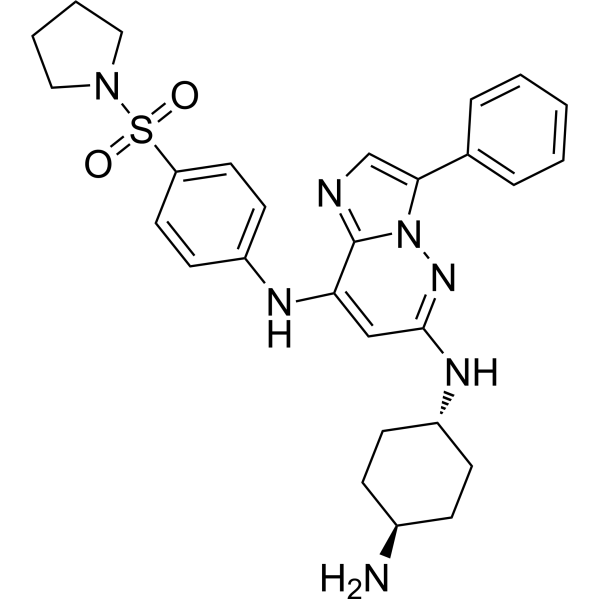
- HY-16018A
-
|
ABT-348 hydrochloride
|
Aurora Kinase
PDGFR
VEGFR
|
Cancer
|
|
Ilorasertib (ABT-348) hydrochloride is a potent, orally active and ATP-competitive aurora inhibitor with IC50s of116, 5, 1 nM for aurora A, aurora B, aurora C, respectively. Ilorasertib hydrochloride also is a potent VEGF, PDGF inhibitor. Ilorasertib hydrochloride has the potential for the research of acute myeloid leukemia (AML) and myelodysplastic syndrome (MDS) .
|
-
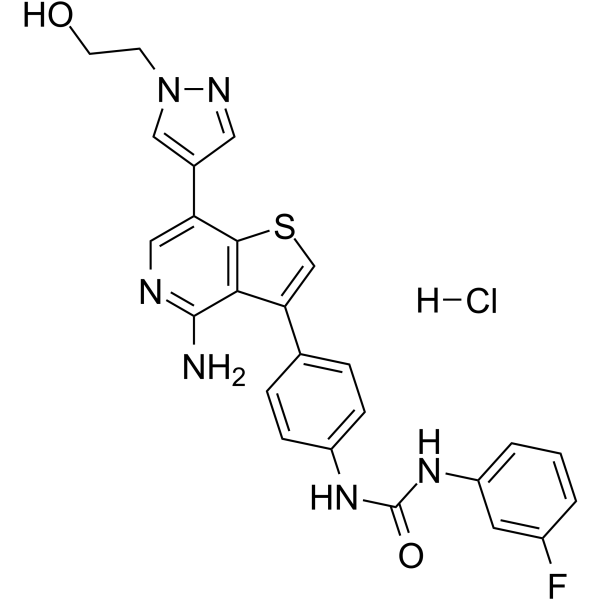
- HY-16018
-
|
ABT-348
|
Aurora Kinase
VEGFR
PDGFR
|
Cancer
|
|
Ilorasertib (ABT-348) is a potent, orally active and ATP-competitive aurora inhibitor with IC50s of116, 5, 1 nM for aurora A, aurora B, aurora C, respectively. Ilorasertib also is a potent VEGF, PDGF inhibitor. Ilorasertib has the potential for the research of acute myeloid leukemia (AML) and myelodysplastic syndrome (MDS) .
|
-

- HY-120877
-
|
|
Salt-inducible Kinase (SIK)
AMPK
Apoptosis
|
Cancer
|
|
MRT199665 is a potent and ATP-competitive, selective MARK/SIK/AMPK inhibitor with IC50s of 2/2/3/2 nM, 10/10 nM, and 110/12/43 nM for MARK1/MARK2/MARK3/MARK14, AMPKα1/AMPKα2, and SIK1/SIK2/SIK3, respectively . MRT199665 causes apoptosis in MEF2C-activated human acute myeloid leukemias (AML) cells . MRT199665 inhibits the phosphorylation of SIK substrate CRTC3 at S370 .
|
-

- HY-151411
-
|
|
Others
|
Cancer
|
|
RUNX1/ETO tetramerization-IN-1 is a small-molecule inhibitor of RUNX1/ETO tetramerization, exhibits anti-leukemic effect. RUNX1/ETO tetramerization-IN-1 specifically targets to NHR2 of RUNX1/ETO (EC50=0.25 μM), restores gene expression down-regulated by RUNX1/ETO. RUNX1/ETO tetramerization-IN-1 inhibits the proliferation of RUNX1/ETO-depending SKNO-1 cells, and reduces the RUNX1/ETO-related tumor growth in a mouse model .
|
-
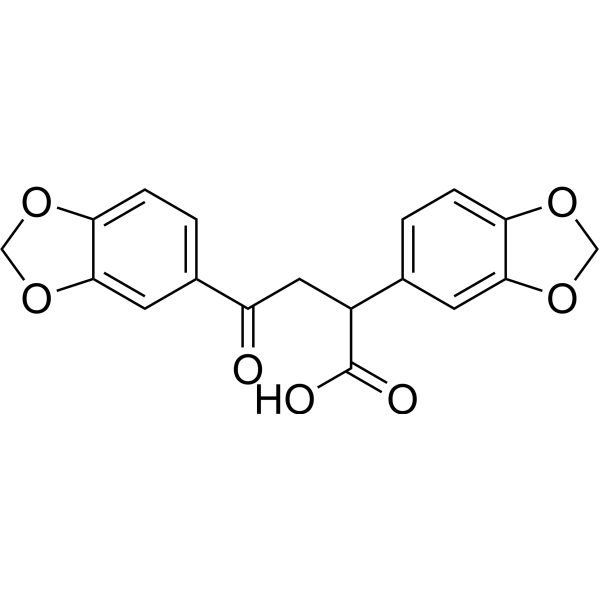
- HY-143877
-
|
|
HDAC
|
Cancer
|
|
NN-390 is a potent and selective HDAC6 inhibitor, with an IC50 of 9.8 nM. NN-390 penetrates the blood-brain barrier (BBB). NN-390 shows study potential in metastatic Group 3 MB (medulloblastoma) .
|
-

- HY-16398
-
|
|
DNA Alkylator/Crosslinker
|
Cancer
|
|
Pipobroman is a bromide derivative of piperazine and acts as an alkylating agent. Pipobroman plays its role by inhibiting DNA and RNA polymerase or by reducing pyrimidine nucleotide incorporation into DNA. Pipobroman can be used for the cancer research, including polycythemia vera, myeloproliferative neoplasm, and AML et.al .
|
-

- HY-13560
-
AVN-944
4 Publications Verification
VX-944
|
Arenavirus
DNA/RNA Synthesis
Apoptosis
Caspase
Bcl-2 Family
|
Infection
Cancer
|
|
AVN-944 (VX-944) is an orally active, potent, selective, noncompetitive and specific inhibitor of IMPDH (inosine monophosphate dehydrogenase). AVN-944 is an essential rate-limiting enzyme in de novo guanine nucleotide synthesis. AVN-944 is also an inhibitor of arenavirus RNA synthesis, and blocks arenavirus infection. AVN-944 has broad anti-cancer activities, and can be used for multiple myeloma (MM) and acute myeloid leukemia (AML) research .
|
-
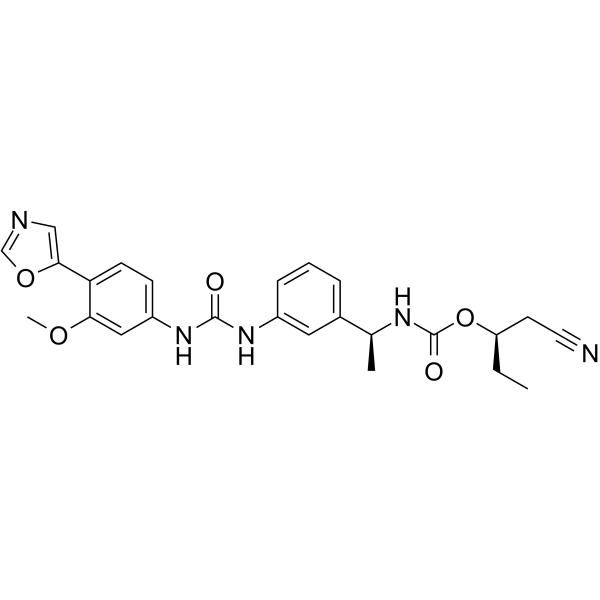
| Cat. No. |
Product Name |
Target |
Research Area |
-
- HY-P99390
-
|
MCLA 117
|
CD3
|
Cancer
|
|
Tepoditamab (MCLA-117) is a bispecific monoclonal antibody that binds to CLEC12A of myeloid cells and CD3 of cytotoxic T cells. Among others, CLEC12A is a myeloid differentiation antigen. Tepoditamab (MCLA-117) kills AML leukaemia mother cells and AML leukaemia stem cells, induces T cell-mediated proliferative lysis of AML cells and can be used in acute myeloid leukaemia (AML) research .
|
-
- HY-P99623
-
|
MGD006; S80880
|
CD3
|
Cancer
|
|
Flotetuzumab (MGD006; S80880) is an investigational CD123/CD3 bispecific dual-affinity retargeting antibody (DART) molecule. Flotetuzumab reactivates T cells by simultaneously binding to CD123 in target cells and CD3 in effector T cells, leading to T-cell-mediated cytotoxicity in target cells. Flotetuzumab shows inhibitory effect on a mouse model of patient-derived xenograft (PDX) in acute myeloid leukemia (AML) .
|
-
- HY-P99014
-
|
|
Apoptosis
|
Inflammation/Immunology
|
|
Cusatuzumab is a human αCD70 monoclonal antibody. Cusatuzumab shows cytotoxicity activity with enhanced antibody-dependent cellular. Cusatuzumab reduces leukemia stem cells (LSCs) and triggers gene signatures related to myeloid differentiation and apoptosis. Cusatuzumab has the potential for the research of Acute myeloid leukemia (AML) .
|
-
- HY-P99394
-
|
JNJ-64407564
|
CD3
|
Cancer
|
|
Talquetamab (JNJ-64407564) is a humanized bispecific antibody that binds to GPRC5D (member of G protein-coupled receptor family C5 group D) and CD3 to induce T cell-mediated killing of GPRC5D-expressing MM cells through T cell recruitment and activation. Talquetamab (JNJ-64407564) has antitumor activity .
|
-
- HY-P99395
-
|
JNJ 56022473; CSL 362
|
Interleukin Related
|
Cancer
|
|
Talacotuzumab (JNJ 56022473; CSL 362) is an IgG1-type fully humanized, CD123-neutralizing monoclonal antibody containing a modified Fc structure. Talacotuzumab has KDs of 0.43 nM, 188 nM, 46 nM, 16.8 nM for CD123, CD32b/c, CD16-158F, CD16-158V, respectively. Talacotuzumab inhibits IL-3 binding to CD123, antagonizing IL-3 signaling in target cells. Talacotuzumab has mutated the Fc region to increase affinity for CD16 (FcγRIIIa), thereby enhancing antibody-dependent cell-mediated cytotoxicity (ADCC). Talacotuzumab is highly effective in vivo reducing leukemic cell growth in acute myeloid leukemia (AML) xenograft mouse models .
|
| Cat. No. |
Product Name |
Category |
Target |
Chemical Structure |
Your information is safe with us. * Required Fields.
Inquiry Information
- Product Name:
- Cat. No.:
- Quantity:
- MCE Japan Authorized Agent:























































































































